News
EIT recently embarked on a roadshow through southern Africa, covering hot trends in engineering, job prospects across the engineering disciplines, and troubleshooting tips.
Dean of Engineering Dr. Steve Mackay and Edwina Ross presented an interactive seminar on ‘engineering as a noble profession’ to aspiring engineers and industry professionals in South Africa, Namibia, and Botswana.
 In the crowds were EIT alumni, current students, prospective students, and curious engineering enthusiasts. The seminars did focus on the noble profession of engineering and its immutable age-old principles. However, Dr. Mackay also demonstrated how the industry is changing thanks to globalization and advanced technologies.
In the crowds were EIT alumni, current students, prospective students, and curious engineering enthusiasts. The seminars did focus on the noble profession of engineering and its immutable age-old principles. However, Dr. Mackay also demonstrated how the industry is changing thanks to globalization and advanced technologies.
“We are hyper-connected: mobile apps, emails, social media, and a quickly updating web. Analytics and predictive models are appearing. One of the great programming languages is Python. There are incredible tools you can use in your career. Everything is in the cloud; you can derive huge resilience by working under the cloud. If it weren’t for the cloud, we wouldn’t have a college,” Dr. Mackay said.
He noted that engineers are finding employment in a plethora of industries they might never have considered before due to the changing nature of the industry, learning, and training under the fourth industrial revolution.
“Engineering is increasingly driven by technology, and these technologies change rapidly. In response, engineers need to become more versatile. There is downward pressure on repetitive jobs in industry today.
“You have to take ownership of your education and training. That’s why you guys are here because you’re proactive in your learning. We believe that engineering skills are becoming more and more generalistic. Today you have to go cross-disciplinary and become a highly-skilled generalist.”
EIT as a solution to conquering the automation future
“EIT is a creature of the fourth industrial revolution,” Dr. Mackay said. The seminar highlighted EIT’s Industrial Automation qualifications, which have been specially created to conquer the challenges brought about by the technically demanding fourth industrial revolution.
In a wisdom-of-the-crowd practical exercise, seminar attendees were divided into groups to come up with automation solutions for several industries. They had to devise innovative solutions for automating a service station, a pizza shop, and an iron ore mining operation. The exercise demonstrated how cross-disciplinary the engineering solutions are to some of the world’s most complex technological problems. It also inspired the participants to think above and beyond what the role of the traditional engineer is.
The participants displayed immense creativity, which provided a fantastic insight into how the advent of automation has transformed the minds of both working and prospective engineers.
Dr. Mackay encouraged the attendees to explore the development of their critical thinking and investigate becoming shrewd entrepreneurs. His mantra is: “Experience together with life-long learning is critical for your career.”
A plethora of options with EIT
EIT’s College Manager Paul Celenza attended the seminar in Johannesburg, South Africa. He spoke to the crowd about EIT’s many study options to suit students of all different walks of life. He also described the methodology of how the institute delivers its courses.
“We have a whole gambit of different courses we provide to different students. We have live webinars where we link up students with lecturers in real-time. We have academically qualified instructors that have years and years of industry experience. They speak the same technical engineering languages that you do. We are ready to host you and get you fully equipped to thrive in your career.”
 Representatives from EIT travel the world to demonstrate our unique online and on-campus delivery modes. These both make use of live and interactive webinars, an international pool of expert lecturers, dedicated learning support officers, and state-of-the-art technologies such as hands-on workshops, remote laboratories, and simulation software. Students can study online from anywhere in the world, or they can study select degrees on campus in Perth or Melbourne. Our supportive blended learning model and small class sizes allow you to advance your technical knowledge and remain engaged in your studies while forming global networks and balancing life and work commitments.
Representatives from EIT travel the world to demonstrate our unique online and on-campus delivery modes. These both make use of live and interactive webinars, an international pool of expert lecturers, dedicated learning support officers, and state-of-the-art technologies such as hands-on workshops, remote laboratories, and simulation software. Students can study online from anywhere in the world, or they can study select degrees on campus in Perth or Melbourne. Our supportive blended learning model and small class sizes allow you to advance your technical knowledge and remain engaged in your studies while forming global networks and balancing life and work commitments.
On this trip, EIT was seeking to prove to the participants that we can provide them with high-quality engineering education and training. Prospective students were most interested in the EIT programs that are accredited by Engineers Australia and therefore are recognized under international engineering accords.
“Our visit was exceedingly valuable. The African continent is hungry for education and innovation. The continent is brimming with resilient engineers. The region’s technological capabilities have grown by leaps and bounds. More Africans than ever are connected to the internet, and that is ensuring that they can come and study with EIT and fulfill their work responsibilities at the same time,” Dr. Mackay concluded.
March 8th marks International Women's Day 2020, a global day that celebrates the social, economic, cultural, and political achievements of women. We wanted to take this opportunity to highlight the valuable contributions from women at the Engineering Institute of Technology (EIT) and the movements they are making to break through the glass ceiling.
In 2017, the World Economic Forum released its global figures on women in engineering. They reported that around 20% of engineering graduates are women, but only 13% of the engineering workforce is female. A lot has been done to elevate female engineers in the last couple of years, but there is still work to do. Getting girls ready and prepared for the world of STEM work is one of the major challenges of our time.
Thus, the importance of introducing young girls to STEM subjects at an early schooling level is paramount. We consulted our very own Deputy Dean of Engineering at EIT, Indumathi V, to collect her thoughts on the ongoing challenge of getting more women into engineering. She believes that it is essential for young girls to be aware of the various career options and study pathways available to them.
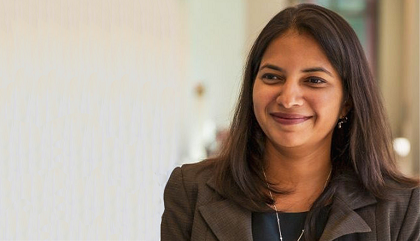
"Education is the foundation to a better society. Engineering is the field that is a pillar in providing economic, environmental, health and security benefits to society. I am a strong advocate for girls and women in STEM. I am encouraged by being a mum of two young girls and a boy myself. It is important that girls are aware of any capabilities that they need to develop from a young age to nurture their interest in the field. I have run some successful initiatives and actively participate in events that promote girls in STEM."
Indumathi is passionate about innovating in the educational space and getting more people educated and trained in engineering. She understands, however, that the prospect of studying towards a career in engineering is a daunting one. Retaining the interest in mathematics in young adults is becoming harder and harder. Indumathi said:
"I was a student who was not very good at maths when I was young. It wasn't until my year 10 when maths started finally making sense, and my confidence grew to pursue Engineering. That making sense led me to understand the importance of a passionate teacher, good pedagogy, good training, well rounded education and how it changed my pathway. Both engineering and education share synergies of making a positive impact on the future generation and society."
Revolutionizing the way education is delivered is necessary to include girls and women, particularly in developing nations, in engineering education and training. Indumathi is currently pursuing her Ph.D. on the topic of Engineering and Education at the University of Southern Queensland.
Her research work includes looking at how institutes can combine technologies to assist students and teachers in the learning environment. After joining EIT in January 2019, Indumathi has helped the institute grow from strength to strength as the institute looks to ways to revolutionize the dissemination of engineering education and training.
"EIT has grown very strongly since I started at the beginning of 2019. Their innovative approach to accessible, flexible, and high-quality education is like no other in the world. The success is strongly attributed to the passionate team of lecturers and staff here at EIT.
"We are always looking at ways to do things better and are very student-centric. While we have a young growing on-campus program, we are growing strongly every day and have achieved some great recognition via professional accreditation of our programs and via our staff and student publication list growing strongly."
Works Cited
Hutt, Rosamond. "Why Do so Many Women Leave Engineering? Probably Not for the Reason You're Thinking." World Economic Forum, www.weforum.org/agenda/2016/11/why-do-so-many-women-leave-engineering?utm_content=buffer43a1f&utm_medium=social&utm_source=facebook.com&utm_campaign=buffer&fbclid=IwAR2z4QcvQV23dIrMlaP1N8l_jSjUUQN0ifpNAfdTgU7xINGywP6qhjHw6sw.
Transformative technologies demand flexibility in the modern era. Consumers demand that technologies be smaller, thinner, wearable, fireproof, bendable, etcetera. On top of all that, the battery still needs to hold a charge.
In Busan, South Korea, a company named Jenax has been hard at work at revolutionizing the lithium-ion battery. They are ensuring a battery can scrunch, bend, flex, and more. The battery is called the J-Flex. And it looks like this:

Jenax says they have batteries as small as 0.5 millimeters that could power sensors, with their biggest battery being a 200mm by 200mm battery. The company says after 1,000 charge-discharge cycles, the cells retain 90% of their capacity.
Creating ultra-flexible batteries that can twist and turn increases the chances of flammability. Lithium-ion batteries are prevalent in many of the technologies that we plug-in to charge every day. Most notably, our smartphones, smartwatches, and tablets.
Jenax has created a non-flammable liquid electrolyte solution for their batteries. Lithium-ion batteries are well known to suffer from a phenomenon known as thermal runaway once the battery gets too hot. The company has 100 patents related to its flexible battery technology. Jenax is keeping mum on how they achieve their level of flexibility, and rightly so, due to the market heating up.
Director of Jenax, EJ Shin, said in a statement, “Liquid is the best conductor for ionic movement, which means it delivers the best battery performance. But because liquid can also be a tremendous fire hazard, many manufacturers try to use solid state electrolyte instead. They sacrifice efficiency and in the case of wearables, comfort and usability, for safety. Jenax has always been focused on delivering the greatest combination of safety and performance. With this non-flammable electrolyte - we’re taking both to the next level - providing peace of mind manufacturers and consumers need with the high performance they deserve.”
Here is a safety test that demonstrates how other lithium-ion batteries fair when undergoing stress tests:
The company says their battery can be used to revolutionize the following battery-powered technologies:
IT wearables
- Smart Watch
- Smart Glasses
- Headset
Health
- Fitness Band
- Medical Device
Fashion
- Smart apparel
- Accessories
Military
- GPS Tracker
- Military Helmet
- Wearable Robot
The company recently showcased their flexible batteries at the Consumer Electronics Show which took place in Las Vegas from Tuesday the 7th of January to the 10th of January 2020.
Jenax showed their willingness to see their battery tech installed into other companies’ applications. They reportedly powered a sensor-lined football helmet developed by HP1 Technologies. Engineers are being called to see where they could implement the flexible batteries in their daily applications.
On the eve of their appearance at CES, EJ Shin explained, “Too many connected products fail to attract customers because they are awkward, uncomfortable, or difficult to use. Hardware designers often tell us that traditional battery limitations - including rigidity, thickness and lack of flexibility - are getting in the way. We created J-Flex specifically to help innovators overcome these challenges and meet consumers’ needs.”
Works Cited
“Jenax Announces Snack & Demo Sessions on Ultra-Flexible Batteries at CES 2020 | Markets Insider.” Business Insider, Business Insider, markets.businessinsider.com/news/stocks/jenax-announces-snack-demo-sessions-on-ultra-flexible-batteries-at-ces-2020-1028719460.
Zenopa. “Jenax Announces a Non-Flammable Liquid Electrolytes Solution.” Recruitment Within Pharmaceutical Jobs, Medical Jobs, Scientific Jobs, Tech PR Jobs, Zenopa, 3 Jan. 2020, www.zenopa.com/news/1976/jenax-announces-a-non-flammable-liquid-electrolytes-solution.
Armando D. Ngojo is an Engineering Institute of Technology graduate who recently completed our 52705WA - Advanced Diploma of Biomedical Engineering.
Currently working in the healthcare engineering industry for a company that maintains and manages medical equipment, Armando has spent fifteen years in the technological side of the medical industry. However, Armando’s interest in engineering began at a young age.
“When I was younger, I was very fascinated with the functionality of the transistor radio. I opened it up and saw a lot of small things and components which fired up my curiosity. I was amazed at how a television worked. How a refrigerator cooled the items inside of it intrigued me.”
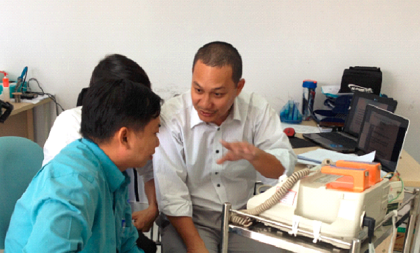
In his secondary school years, he pursued his love for technology further by enrolling in an elective that covered electricity & electronics. After high school, he began to pursue a career in Electronics Engineering. However, Armando’s road to an engineering career was not an easy one.
“When I was in college, I went through a lot of ups and downs. Initially, in 1996, I was a freshman scholar with tuition discounts but it was abruptly terminated after the first semester only. I failed the cut-off grades to maintain the discounted fees,” explained Armando.
“I was also out of university the following year due to financial issues. In order for me to continue my studies in the year after my hiatus, I became a working student and helped my family survive while pursuing my degree.”
In college, Armando had the opportunity to work with simple medical equipment like suction machines and OT lights in conjunction with his studies at college. It was in that role where his interest in the healthcare engineering industry was sparked.
After graduating from college, Armando got a job at a local medical sales and service company in the Philippines as a Biomedical Service Engineer. This role unlocked a world of opportunities, which resulted in Armando working full-time in Malaysia for seven years, Vietnam for one year, and Abu Dhabi and Dubai for more than five years.
After many years of working in the industry, Armando felt that he wanted to take the next step in advancing his career. He went on a search for a biomedical engineering course that would allow him to upskill even further, and that is when he discovered EIT. He noticed our Advanced Diploma in Biomedical Engineering was exactly what he needed.
“I took the course because although I was already working in the healthcare industry for the last 15 years, I lacked a proper school qualification. This is due to my home country; in the Philippines, no university was hosting a real course in Biomedical Engineering in my time.”
Since he has graduated, Armando has found that his daily responsibilities at work have become easier to manage.
“Professionally, I got a promotion within my company and was given more responsibilities, and of course, better remuneration. My newly acquired qualification also opened up a lot of opportunities for me. Being an EIT graduate was a power credential in my portfolio.”
He is now waiting for EIT to begin hosting a Master’s Degree in Biomedical Engineering so that he can continue building on his knowledge base in the technological realm of the healthcare industry. He concluded:
“I am very interested in pursuing further studies in this field due to the fact that with my current job requirements, the face to face interaction with medical officers like nurses, lab technicians, radiographers, and doctors are always imminent. I need to learn how to converse with them using medical terminologies they understand. I am talking to them with more self-assurance after graduating with EIT.”
Armando is fascinated by the developments occurring in the biomedical engineering industry. He says that the emergence of AI and 3D printing of organs has been particularly interesting to watch. He says the course through EIT delved into some of those topics and opened his eyes to the development occurring in the space. As the industry continues to grow, he sees his career growing.
“My career maturing in the upcoming years is a definite! I know that the industry that I am currently in will become very competitive in the coming years, but I am very confident that I will survive because my years of extensive experience in the industry are already backed up by my proper and formal school qualification achieved through one of the best technical schools in Australia: EIT.”
Islam Sarwat graduated from EIT in 2015 with a 52742WA - Advanced Diploma of Plant Engineering. Before completing the program, he was an in-training operation and mechanical engineer. He noticed that he had some spare time on his hands and a dream to attain a senior engineering job in the future.
Islam chose this particular program because, he says, it was comprehensive and covered a lot of material that would improve his knowledge and enhance his skills. He also knew it would help him find direction in his career.
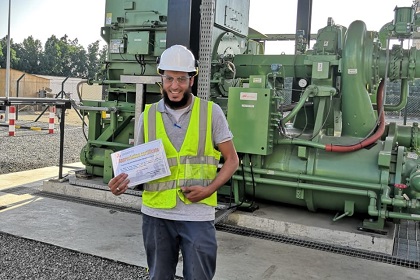
“My studies helped orient me in choosing which engineering industry to go into. The engineering industry has a lot of different varieties and disciplines. Instead of one particular field, it includes many different fields.”
Islam found that the pathways to being hired in a high-level job became more likely after completing the plant engineering program.
“Life was better. I felt that I did what should be done to enhance my skills. I extracted immense value from my studying with EIT. The course definitely added to my skill set in my work environment.”
After three years of studying, he got what he was hoping for: Islam was appointed as a project lead in the new extension of the plant for the company he was working for in the Industrial Gases industry. His daily responsibilities include:
- Process optimization
- Efficiency enhancement
- Preparing reports regarding plant performance
- Preparing maintenance and operation budget
- Carrying out preventive and corrective maintenance
- Implementing production plans
Islam is looking forward to the future challenges his career in engineering may throw at him. And now, he is looking to the next career challenge of leveling up to more senior (and managerial) positions.
“I have met the challenges that have come as my career has matured. I overcame these challenges, developed my skills, and improved myself by studying and training in my field. I for sure, have a better future. I plan to improve my managerial skills to shift from the technical world to managerial positions.”
Legal Wise, a law institute in South Africa, defines retrenchment quite aptly, “Retrenchment is a form of dismissal due to no fault of the employee, it is a process whereby the employer reviews its business needs in order to increase profits or limit losses, which leads to reducing its employees.”
In some instances, automation has meant that some jobs no longer require human intervention. For example, in the banking sector, many physical branches have closed down or downsized as Internet banking takes over.
 In the engineering world, mining companies have also been badly hit. For example, in September 2019, mining conglomerate Sibanye-Stillwater indicated that 5,270 jobs (or roughly 6% of their workforce) would have to be cut after financial losses at their mines. In 2017, Platinum producer Lonmin announced that it would lay off 12,600 workers over three years.
In the engineering world, mining companies have also been badly hit. For example, in September 2019, mining conglomerate Sibanye-Stillwater indicated that 5,270 jobs (or roughly 6% of their workforce) would have to be cut after financial losses at their mines. In 2017, Platinum producer Lonmin announced that it would lay off 12,600 workers over three years.
However, while some jobs are no longer as in-demand as they once were, advances in technology mean new roles are being created all the time. Here are some tips for surviving retrenchment.
Tweak your CV and get back to job hunting
Updating your curriculum vitae to be in line with modern recruitment practices is essential. Our Dean of Engineering at EIT, Steve Mackay, has a few tips on where to begin with your CV.
“First of all, ensure your CV is designed for the particular job you are applying for,” he said.
“Your CV should use plain English and the information should be laid out simply and logically…and leave lots of white space. Grammar and spelling must be one hundred percent accurate.
“Avoid too much detail; the CV that is 20 pages long is not acceptable. An executive summary at the top of the resume is a good idea. Be specific! Focus on the job you really want. Your CV should also include business strengths and business wins.”
You can also utilize your network here. Check up on previous employers, see if they have any vacant positions you could fill. Talk to colleagues and friends you have amassed along the way in your career. Your next job could be a phone call away.
Upskilling for the future of work
Growing your skillset is imperative. Many industries are automating more and more of their operations, which may leave the role you are performing redundant. Therefore, undertaking professional development in cutting edge areas of the engineering industry is essential.
The Engineering Institute of Technology provides professional certificates of competency, diplomas, advanced diplomas, and bachelor’s and master’s degrees in crucial engineering disciplines with updated curriculums that prepare you for the technologies you can expect to see in the workplaces of the future.
Entrepreneurship
Market your skills as a freelancer or an independent contractor to get work after you have been retrenched from a company. Depending on where you are in your career, you could continue doing that for a reasonable amount of time. In fact, some engineers are noticing that they can also create several side-hustles that generate money they can use to achieve even bigger things later on in life.
Retrenchment doesn’t have to be the end of the world for you. It can be the beginning of a new chapter in the book of your career. Keeping a level head and carrying on with making the most of the skills you have amassed, or looking into educating yourself further, are all important mechanisms to surviving any tough patch.
Works Cited
Retrenchment Tracker: South Africa's Big Corporate Job Losses in 2019 - so Far, www.businessinsider.co.za/total-number-of-job-losses-south-africa-retrenchment-corporate-job-losses-2019-6.
“Retrenchment Process and Procedure: QuickLaw Guide.” LegalWise, www.legalwise.co.za/help-yourself/quicklaw-guides/retrenchment.
Lucinda Krige is a South African inspiration. She is a qualified Marine Engineer Officer who, since 2003, has been working for renowned seafood processing company Sea Harvest. She currently works as a HR Business Partner in Learning and Development at Sea Harvest.
She was the first woman to qualify as a Chief Engineer in the fishing industry in South Africa. The sector produces 80 million tons of food and employs 40 million people across the globe.
Sea Harvest is a company that was established in 1964 on the Atlantic West Coast of South Africa. They are headquartered in Saldanha in the Western Cape. They catch and package seafood, exporting it to 22 countries.
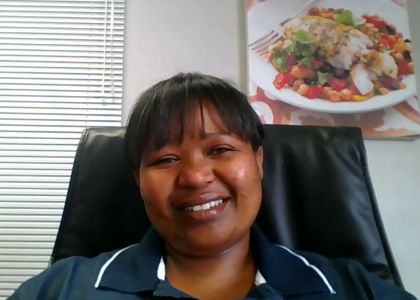 Lucinda, being the first female engineering cadet in the fisheries industry to rise up the ranks to become a Chief Engineer, is a role model to the many unemployed youths in South Africa who are desperately seeking the kinds of opportunities she has worked for.
Lucinda, being the first female engineering cadet in the fisheries industry to rise up the ranks to become a Chief Engineer, is a role model to the many unemployed youths in South Africa who are desperately seeking the kinds of opportunities she has worked for.
Lucinda started with Sea Harvest as an engineering cadet in 2003. Sea Harvest, at the time, was recruiting cadets via the newspaper. Lucinda’s father drew her attention to the article, saying she should perhaps pursue it.
“I asked him what it was about - he didn’t know, and neither did I,” she said.
“But, I applied and was successful. When I boarded my first vessel, that is when I started to discover what marine engineering was all about, and life at sea - the rest is history.”
At the age of 20, Lucina began the grueling process of practically learning the ins and outs of the technologically advanced trawler vessels used in the fishing industry. She had to learn everything from the operation to the maintenance of the fishing vessels during her time as a cadet. Almost every single time she boarded a ship, she was the only woman on board.
“When you start out in the field, you start as an engineering officer, that’s the first level,” she said.
“You start with the basic knowledge of various disciplines. That is where your workshop training comes in, because those are your hand-skills, that you have to get under the knee.
“For instance, your winch system onboard the vessel includes hydraulics, pneumatics, and electronics. Then there is refrigeration, electrical, engines — which is the mechanical part, and controls section. You start out with a cluster of skills that you need to familiarize yourself with.”
For a detailed look at the five years of of theoretical training and work experience Lucinda conducted to obtain her qualification as chief engineer, watch her chat with me here:
Breaking the glass ceiling
Lucinda and her father took a keen interest in stories of female engineers in the newspapers. This, coupled with her love for mathematics and science, led to her pursuing a career in the engineering industry. She says working in a male-dominated industry was not too intimidating to her.
“The funny thing about my career choice is that when I was little, my father would always ask what I wanted to be when I grow up. This was back in the 80s. I had this thing of wanting to be a policewoman. My father asked why I wanted to do it, and I said it was something that I didn’t see a lot of women doing.
“When I was in primary school, I came home with the newspaper that had an article in it about the first female civil engineer in South Africa that was part of a bridge project. That’s when I decided I wanted to do engineering.”
It has been eleven years since Lucinda was sea-bound as an engineering cadet with Sea Harvest. She now chuckles when she says she has ‘hung up her overalls’ for an on-shore job.
She now heads up the technical and maritime training at Sea Harvest’ Saldanha headquarters. She ensures that the curriculum is up to date in accordance with the vessels so that the ships can be safely manned.
The training helps both those who have no formal qualifications and those who do, level up in the maritime industry in the country. Lucinda sits on advisory committees and is a fishing industry representative that speaks at government events as well. Sea Harvest takes in unemployed youth in South Africa and puts them through an apprenticeship program that helps them become artisans in the fishing industry in South Africa.
While the Engineering Institute of Technology has campuses in Perth, Western Australia, and Melbourne, Victoria, we predominantly run as an online institute that sees thousands of students logging in and out every day. For students who are part of our online learning cohort, internet connectivity is imperative.
We are proud to have students from all over the world who have earned Australian accredited diplomas and degrees through our unique online delivery model. We are, however, aware of the challenges many countries face with limited internet connectivity.
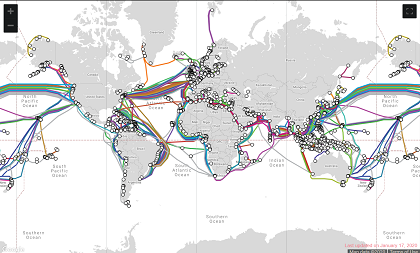 According to Internet World Stats, there are 525,148,631 internet users in Africa. The continent’s population is said to be 1.216 billion people, according to estimates compiled in 2016. About 690 million people are, therefore, without access to life-changing internet technologies.
According to Internet World Stats, there are 525,148,631 internet users in Africa. The continent’s population is said to be 1.216 billion people, according to estimates compiled in 2016. About 690 million people are, therefore, without access to life-changing internet technologies.
In 2017, the United Nations (UN) reported that more than half of the world’s population still does not have access to the internet, with Asia and Africa facing the lowest connection rate. It has now set a goal for universal access to the internet — which would equate to 90 percent of the world population — by 2050.
Facebook and Amazon have been experimenting with the research and development of internet-for-all technologies. Engineers are deeply involved in how nations connect to the internet. While philanthropic companies undertake the challenge of creating new, still-to-be-debuted, mobile internet technologies, the tech that connects the world to the internet has its fair share of maintenance issues.
How is the internet provided to the world?
Ninety-nine percent of international internet data is transmitted through a series of submarine cables spread across the ocean floor across the globe. There are 300 undersea cables transmitting data underwater, ensuring nations get internet connectivity.
However, when these connections become damaged, the internet traffic from the directly affected countries is rerouted through working cables. This impacts speed and accessibility.
For example, on the west coast of Africa, the West Africa Cable System (WACS) and South Atlantic 3 (SAT3) form international links that connect southern Africa to the world.
WACS connects South Africa with the United Kingdom. The SAT3 cable connects South Africa to Portugal and Spain. Both of these cables were damaged by gale winds earlier this year, impacting the entire collection of southern African internet service providers.
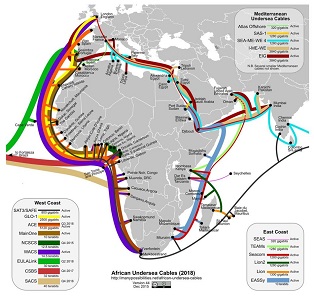
On the east coast of Africa, the SEACOM and EASSy cables are receiving rerouted international internet traffic from the western parts of the country where the cables are down.
This meant internet service providers had to continue buying international bandwidth from SEACOM to keep international traffic ticking along for their consumers.
The future of internet connectivity
Are undersea cables set to be the norm for internet connectivity a century from now? Is South Africa’s cautionary tale of gale-force winds and broken undersea cables enough food-for-thought for engineers to come up with more innovative ways of connecting the world to the internet?
Some internet service providers in southern Africa offer competitively priced high-speed satellite internet. Satellite internet is useful, especially in rural areas that do not have fixed and wireless internet infrastructure. South African born Elon Musk’s aerospace company SpaceX, has recently launched a satellite network named Starlink that will help provide low-cost internet to remote locations.
The U.S. Federal Communications Commission (FCC) has given the company clearance to launch 12,000 small satellites and may allow them to push the number to 42,000 in the future. Around 242 satellites are already in space. Ongoing research and development of internet technologies, such as SpaceX’s Starlink, are going to have to go into hyperdrive to meet the UN’s target of 90% of the earth’s population being connected by 2050.
Works Cited
“Africa Internet Users, 2019 Population and Facebook Statistics.” Internet World Stats, www.internetworldstats.com/stats1.htm.
Mann, Adam. “Starlink: SpaceX's Satellite Internet Project.” Space.com, Space, 17 Jan. 2020, www.space.com/spacex-starlink-satellites.html.
South Africa needs more medium-skilled workers. The youth graduate unemployment rate in the first quarter of 2019, according to Stats South Africa, was 31 percent. The hope is that the first quarter of 2020 may see improvement.
The Minister of Higher Education, Science and Technology, Blade Nzimande, is encouraging matriculants who just received their results in January to consider enrolling in Technical Vocational Educational and Training (TVET) colleges.
 He said most students aim straight for university after completing the twelfth grade, “TVET colleges play a pivotal role in addressing South Africa’s skills needs and cater for a wide spectrum.”
He said most students aim straight for university after completing the twelfth grade, “TVET colleges play a pivotal role in addressing South Africa’s skills needs and cater for a wide spectrum.”
Blulever Education, a new South African higher education group, reports that there is a shortfall of 40,000 people in the artisanal space in the country. The situation is further worsened with unqualified artisans purportedly flooding the market.
In their latest report on the sector, they write, “We found that this is a system with pockets of excellence and institutions that are doing things well in various ways, but that overall the artisan ecosystem is dysfunctional and in need of many interventions. Some issues are systemic, and need to be addressed by large-scale policy or governmental interventions, while others present opportunities for institutions to introduce solutions.”
Nzimande says that 156,800 new studying opportunities are available in the 2020 academic year to students who wish to undertake engineering, general, or business studies. The TVET sector in the country also has its own shortfalls - and that’s where EIT comes in.
EIT is well positioned to help South Africans reach their potential and empower them to get qualified as a technologist or technician. EIT provides an opportunity for these students to graduate with a locally and globally relevant qualification.
The unique online delivery model means students can learn while seeking and undertaking employment. The importance of redefining study and work is clear from the whitepapers in South Africa, and EIT is meeting the challenge head-on.
EIT’s Dean of Engineering Steve Mackay, who will be visiting three South African cities in February, said, “I think in the daily haze of software, theory, paperwork, standards, regulations, procedures, policies and systems we operate in; we tend to forget this as engineering professionals.
“Despite all the changes in engineering today, the engineering craftsman is still a key contributor in the engineering team and should always be accorded enormous respect.”
The Department of Higher Education (DHET) has been nudging students towards artisan education and training since 2014, under a campaign called ‘The Decade of the Artisan.’ The success of this campaign will be measured in 2024.
The DHET is continuing its efforts to motivate students to join the medium-skills industry, and are hoping the economy may be revived through this sector.
EIT is poised to continue helping students in South Africa and beyond reach their education and training goals while gaining work experience. With every passing year, distance learning, coupled with work experience, is becoming the norm. We are dedicated to helping train artisans in the engineering industry up for this ‘decade of the artisan’ and the next.
Works Cited
“Blulever.” Blulever, blulever.com/.
Mafolo, Karabo. “HIGHER EDUCATION: Blade Nzimande Urges Students to Apply to TVET Colleges.” Daily Maverick, www.dailymaverick.co.za/article/2020-01-16-blade-nzimande-urges-students-to-apply-to-tvet-colleges/.
Australia’s fire season has been the most damaging in living memory. The skies have been tinged red by the earth-scorching fires that have burned up about 12 million acres of land in Australia.
The bushfires, which are usually observed between October to March, have been raging since September 2019. They are the worst in the country’s history. Each state has been affected in a variety of ways, but it is New South Wales and Victoria that have been most severely hit by the fires.
As Australia picks up the pieces, while still blazing fires as temperatures soar, engineers are both assisting where they can and wondering how to prevent another disaster like this in the future. Each engineer in every engineering discipline could use their technical studies to the country’s benefit to mitigate future fire events.
Back in 2016, a Research Scientist at IBM, Anna Phan, asked the question: Can we outthink natural disasters? IBM’s artificially intelligent systems could be a potential solution to future flare-ups in the bushfire season in Australia.

On an article posted to LinkedIn, she wrote, “At IBM, our researchers are applying science and technology to tackle problems like predicting which areas and properties are most at risk of bushfires, investigating evacuation plans in hypothetical scenarios, or recommending the best evacuation route in a crisis.”
One of the elements of fire spreading that IBM had to account for as they began their research in 2016 was ember attack. Ember attack happens when burning foliage, twigs, and other flammable materials become airborne after gusts of wind. Larger fires create more embers. Therefore, Australia has seen runaway fires continue to develop.
The civil engineering implications in the aftermath of the fires could be significant. Updating building standards with future fires in mind will be imposed.
Ian Weir, Head of Landscape Architecture at the Queensland University of Technology, who is researching bushfire-affected architecture, spoke to NPR. He explained that in Australia, conventional homes that do not comply with the latest building standards are more flammable. A remedy for that has been cutting away vegetation to create buffer zones for properties. However, with embers spreading over the landscape, conventional homes catch fire in any case. Hence the need for future retrofitting and construction regulations to protect properties from fires in the future.
Newer automated technologies can play a part in prevention, mitigation, and disaster relief.
Anna Phan writes, “By using big data and analytics such as fire spread simulations and traffic modeling, IBM’s researchers have also developed an evacuation planner. This can provide answers to how long it will take to evacuate an area, the impact of road blockages and what shelters are available to help town councils and emergency services better prepare for bushfires.”
Electrical engineers will also be learning vital lessons for future disasters, as the bushfires have threatened electricity distribution. In New South Wales, the bushfires blazed through a link connecting the state’s electricity link with Victoria. Some transmission lines were reduced to rubble which led to pleas from the government to limit power consumption.
Two substations in the Snowy Mountains region were closed, causing 900MW to be lost from the grid - but impressively, electrical engineers managed to keep the lights on thanks to emergency backup sources of power. However, there were some regions, specifically from South Nowra to Moruya, Tumbarumba, and others where power was non-existent due to the ravaging fires.
The crisis is ongoing and will be remembered for years to come. However, the resiliency of the Australian firefighters during this crisis will be most remembered. The world will continue to celebrate them. Their job is not yet complete as they continue to battle fires, which are expected to continue burning. Moreover, the heroic stories of everyday Australians’ survival will number in the thousands after the dust has settled on these bushfires, and each deserves an equal measure of attention.
Works Cited
Hersher, Rebecca. “Australian Fires Prompt Questions About Protecting Houses From Embers.” NPR, NPR, 7 Jan. 2020, www.npr.org/2020/01/07/793991736/australian-fires-prompt-questions-about-protecting-houses-from-embers.
PhanFollowResearch, Anna, and Anna PhanResearch. “Can We Outthink Natural Disasters?” LinkedIn, www.linkedin.com/pulse/can-we-outthink-natural-disasters-anna-phan/.
Sefiwa Monyamane is an engineering professional and Engineering Institute of Technology graduate from Botswana. Currently working at a state-run electricity utility company, Botswana Power Corporation, Sefiwa is a scholar of the world of electrical engineering. But why did he choose the world of electrical engineering and more specifically, EIT?
“New inventions are ever-changing in complexity, especially in power utilities. As an innovative individual, I thought this was the right course and the right field to express my interest in the technologies of the industry.”
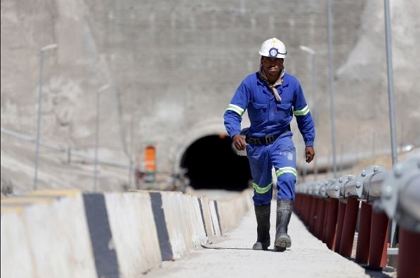
Sefiwa first began to pursue a career in electrical engineering many years ago. He attended Shashe River School between 1999 and 2000. There he received his Botswana General Certificate of Secondary Education (BGCSE) in Physical Sciences. Soon after, he enrolled for a Diploma in Electronics and Electrical Engineering at the University of Botswana, receiving his diploma in 2003.
In 2005, he went on to work in Broadcasting Services as a Transmission Technician. Three years later, he would join the Botswana Power Corporation as a Commercial Technician, working there from 2008 to 2016. It was during this time that Sefiwa enrolled for EIT’s 52727WA - Advanced Diploma of Electrical and Instrumentation (E&I) Engineering in Mining.
Sefiwa enrolled in the program after the profession he was pursuing began demanding that he continue to develop his skills in the industry.
“I have come to understand the entire scope of work across the power industry in the particular sector I am in. It was covered by the modules in EIT’s course. The course captured every aspect of power from generation to distribution, which was useful because now I utilize the knowledge in my daily work.”
In 2016, he found himself fulfilling a role as an Operations and Instrumentation Coordinator at Serviceline Engineering. He remained in that role until rejoining Botswana Power Corporation in 2019, this time, and he worked as Planning Technician for the state utility. His day to day responsibilities include load forecasting and network extensions to cater for future scenarios at the utility.
Sefiwa is looking forward to the remainder of his ever-expanding career and is currently considering enrolling for the Bachelor of Science (Electrical Engineering) with EIT. He is also keen on learning more about renewable energy technologies as he notices the power generation industry moving away from coal-based generation to solar energy. EIT caters to that too — students can seek out the 52764WA - Graduate Certificate in Renewable Energy Technologies.
Sefiwa’s career progression and academic journey is proof that he is an individual dedicated to serving his community, improving lives, and working towards a better future.
“With the dream of obtaining my bachelor's degree, I foresee a change in the way our utility generates its power - especially because the world is embarking on utilizing green technologies. And I want to be ahead of the learning curve when it comes.”
Dear Colleagues
The debate is now moving to whether the current coronavirus (as I write this, more than a hundred people have died) is more virulent than the earlier SARS virus with suggestions that it is even spreading before symptoms are evident. Some comparisons are also being made about the influenza pandemic in 1918 when between 20 and 40 million died near the end of World War I. (More people died in a single year here than in the horrendous Black Death Bubonic Plague from 1347 to 1351).
And we have Cyber Viruses of course
Naturally, there are a plethora of millions of cyber viruses being spread on a second-by-second basis through the internet. These are absolutely horrendously destructive to electronic media and have been known to shatter longstanding businesses and careers. But fortunately, with training and varied isolation techniques combined with a dose of common sense and pro-activeness, they can be kept at bay.

Working Online is a Win-Win-Win on So many Levels
In addition to avoiding the spread of biological viruses, the rapid growth in broadband, the need to reduce travel and accommodation costs as well as reduce harmful emissions (from travel), makes the whole topic of working and learning remotely very relevant today. It’s good to collaborate remotely without the need to physically travel — you can increase productivity, save time and money while reducing your company’s carbon footprint. As well as (today) avoiding spreading harmful diseases.
A Growing Need for Remote collaboration and Online Learning
With the growth of working online, there is a growing demand for remote configuration and testing of systems often performed by teams of engineering professionals collaborating virtually, while scattered at geographically remote locations. Admittedly, there are technical challenges of remote control and configuration on a real-time basis and there is a heightened risk of security breaches with catastrophic consequences for a remote automation project for example. However, the field of remote collaboration and configuration is growing fast.
Needless to say – if you can collaborate online, you can undoubtedly learn online. This is resulting in an explosion in online training and education.
Working in Teams
As engineering professionals, we tend to work in teams. This is often the sales pitch used to encourage the use of a new family of tools allowing for communication, collaboration and coordination. Without the requirement for physical travel.
The market of remote collaboration can be segmented by price and bandwidth requirements and ranges from (at the low end of bandwidth) email/instant messaging/phone calls/audio conferencing / webcasting/web conferencing/video conferencing and the big one – telepresence. The web conferencing is the tool that offers particularly useful features at an affordable cost.
Three Main Functionalities of Remote Collaboration
Remote collaboration is not only just about technology but has three main functionalities:
* Communication – the ability to exchange information between participants
* Co-ordination – the ability to coordinate tasks among the geographically scattered team
* Collaboration – the ability to achieve team goals.
Typical tools range from Gotomeeting, Livemeeting, Electromeet and WebEx. These allow typical web conferencing at an affordable cost. The main methods of delivery of web conferencing are typically using slides, audio, text chat, video streaming, use of a whiteboard, sharing of programs, file transfers and web touring.
In addition, the feature of simultaneously performing remote configuration and testing of a remote site is an added benefit in some of them, and this is the area that really interests me with our research and work. This is especially helpful for our online education using remote labs scattered around the world which our students can access wherever they are located.
The benefits of remote collaboration and testing include:
* Stops the spread of biological viruses
* Good for minimizing harmful emissions
* Convenience
* Easy to use
* Expertise available to more sites
* Higher availability of equipment
* Access to specialized equipment
* No geographical barriers
* Minimisation of travel and accommodation costs – lower greenhouse gases
* Considerably lower costs
How can you take advantage of these tools?
* Think seriously about using remote collaboration, testing, and configuration for your next project
* If you have access to broadband on your remote sites, this makes the decision easier
* Your younger staff would be familiar and comfortable with these tools
* Pay attention to the security of your connections
* Training is required to ensure everyone is skilled at using these tools
Naturally, everyone is not going to go across to 100% remote collaboration. Agreements and contracts often need a personal touch. Informal discussions during tea breaks are difficult to replicate through the sometimes clinical internet. And naturally, critical tests and interfacing with equipment where an expert is required physically on the spot are still essential. And as we all know, in many locations, internet connections are not possible, impossibly slow or tenuous. So as with everything – there is a trade-off required between the online and physically-on-the-spot worlds.
On the topic of remote control, John Alejandro King made the joking remark, which could be one day true: If you're not scared or angry at the thought of a human brain being controlled remotely, then it could be this prototype of mine is finally starting to work.
Yours in engineering learning
Steve
Ijaz Ali is a graduate of the Engineering Institute of Technology based in the United Arab Emirates. He completed his 52724WA - Advanced Diploma of Civil and Structural Engineering in March 2019. He has recently embarked on his journey of acquiring a Bachelor of Science (Civil and Structural Engineering) with EIT.
He chose to study these qualifications because of the industry he works in; he works in the field of Transportation Engineering, which is a subcategory of Civil Engineering.
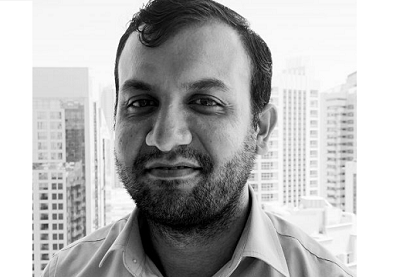
To get to where he is today, he started his journey in 2007 when he did a CAD certificate and worked with an Engineering Consulting office. His affinity for engineering in his day to day work is apparent.
“I chose this field as I was fascinated by how easily and systematically one can solve complex issues through engineering. It is a very well-structured field with proper procedures and standards that govern it, and this is the main reason why I like it.”
Ijaz already had close to eight years of experience in the Transportation Engineering industry before he began building on his skills with EIT.
In those eight years, Ijaz has seen immense development creep into the industry. He has seen mobility as a service, like Uber, become a societal norm. He has seen engineers hypothesize multi-national road traffic safety projects to eliminate all fatalities and serious injuries on roads, otherwise known as Vision Zero. And he has seen the incredible development in the autonomous driving industry. At his current job, he forms part of the ITS & Transportation Team.
“I am involved in the design and studies for different ITS strategies such as the Traffic Control System, Road Weather Information System, FOC Network and CCTV Connectivity. I support the team in preparing drawings, feasibility reports, and traffic studies. Previously I was also involved in the design and studies for Internal Roads, Highways, and Parking areas. I was also involved in obtaining their approvals from the local authorities. I also prepared longitudinal and ROW sections for the same along with the Stormwater, Sewerage & Streetlight design. I also proposed utility corridor designs for it. In addition to that, I have worked with the QS and Project Management team for cost and schedule estimation, for forecasting UpToDate.”
Ijaz now works at the Surface Mobility Consultants head office in TECOM Dubai, where he mostly works on projects with Integrated Transportation Center (ITC – DOT) for the implementation of Plan 2030. He has equipped himself further with Transport Engineering and Project Management short courses to ensure that he remains as proficient in his trade as possible, and gaining domain expertise as he goes along.
“I am still part of EIT as I have continued my studies through the bachelor's program, but I can say that after obtaining my Advanced Diploma, I am now officially recognized as an industry professional and I am also in the process of being recognized by Engineers Australia at the Engineering Associate Level.”
Ijaz has gotten this far in the industry and intends to go even further. He says that the elephant in the room nobody wants to discuss in the industry is the effect of the massive carbon footprint that the transportation industry creates - something he wants to contribute towards fixing.
Sometimes Ijaz tries to fit in some reading into his busy schedule. He encourages people to pick up a copy of ‘Seven Habits of Highly Effective People’ by Stephen Covey. He also encourages young people to pursue a career in engineering as it is ultimately a rewarding career path. He concluded:
“Engineering is an ever-evolving discipline that affects our day to day activities and sustains the system we are currently living in. This is why I would highly encourage young people to consider pursuing a career in this field.”
Autonomous and efficient data-collecting systems will continue to revolutionize engineering industries throughout 2020. The development of these cyber-physical systems is what is enabling the data and sensor-driven efficiency of the fourth industrial revolution forward.
The most cutting-edge of industrial setups in the world are combining cyber-physical systems with large amounts of data, paired with machine learning, in one big interconnected network. This means factories can run with almost no human interference.
Jon Excell, the Editor of The Engineer Magazine, ended his first Editor’s Note of the January 2020 edition by highlighting how engineering innovation and data generation is transforming a plethora of industries.
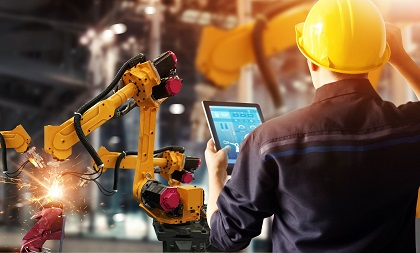
“Few areas of industrial endeavor are untouched by digitalization...engineering innovation - whether it’s destined for the high seas, the operating theatre or the farmer’s field - is increasingly reliant on the intelligent use of data,” he wrote.
“And, as we look further ahead, the degree to which this drives different sectors to collaborate and learn from each other will surely become one of the defining characteristics of modern engineering.”
To get ahead of the ever-expanding automation industry, the Engineering Institute of Technology (EIT) delivers industrial automation programs to students around the globe via a unique online methodology. It makes use of live and interactive tutorials, an international pool of expert lecturers, dedicated learning support officers, and state-of-the-art technologies such as hands-on workshops, remote laboratories, and simulation software.
The supportive blended learning model and small class sizes encourage students to advance their technical knowledge and remain engaged in their studies while forming global networks and balancing life and work commitments.
Students can also apply to study applicable degrees in Australia at their campuses in Perth and Melbourne.
A new cohort of industrial automation students are set to familiarize themselves with the Internet of Things and other technologies that are automatizing the workplaces of the future, thanks to EIT.
EIT also offers short-courses that provide working technologists and engineers with professional development opportunities. These courses all have a specific focus and are designed to help engineers upskill and cross-skill to keep their knowledge relevant as technologies continue to develop and change the nature of their work.
For instance, practitioners working in the industry can opt to do the three-month-long Professional Certificate of Competency in Industrial Data Communications to continue to grow their proficiencies with the kinds of technologies that are embodying the fourth industrial revolution. EIT hosts many other professional development courses, including: ‘Practical Machine Learning using Python for Engineers and Technicians’ and ‘Programmable Logic Controllers (PLCs) & SCADA Systems.’
A technology significantly propped up by the automated systems defining the fourth industrial revolution is industrial robotics.
Robots: From China to the rest of the world
China is a country that is seeing a significant uptake of industrial robotics. The International Federation of Robotics back in 2016 were predicting big things for the year we currently find ourselves in.
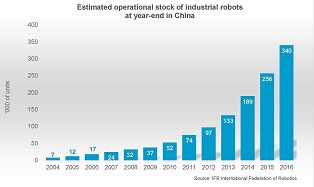
They wrote, “China has rapidly become a global leader in automation. From 2018 to 2020, a sales increase between 15 and 20 percent on average per year is possible for industrial robots... China intends to forge ahead and make it into the world’s top 10 most intensively automated nations by 2020. By then, it’s robot density is targeted to rise to 150 units - this being the number of industrial robots per 10,000 employees.”
A report by the Wuhan University of Quality Development Strategy predicts that if China’s goals are met, by 2025, automation will replace at least 5% of the Chinese workforce. The report purportedly surveyed 2,000 companies in China. This trend is expected to be observed at varying levels globally.
The onus is thus on students to grow their skill sets, and pepper their careers with creative and entrepreneurial endeavors within their industry. This will ensure that they stay ahead of the curve as automation replaces the repetitive tasks of the past. The advent of automation was also never intended for the mass-replacement of workers. It is being spearheaded to open up new avenues for workers to do much more meaningful work.
Nonetheless, the need for skills development still stands. Companies have a new responsibility to keep workers skilled, but workers too are expected to keep on developing themselves as the job markets change around automation. Will you rise to the automation challenge in 2020?
Works Cited
“BACK ISSUES |.” The Engineer, www.theengineer.co.uk/back-issues/.
Papadopoulos, Loukia. “By 2025 Nearly 5% of China's Workforce Will Be Replaced by Robots, Reveals New Survey.” Interesting Engineering, Interesting Engineering, 23 Dec. 2019, interestingengineering.com/by-2025-nearly-5-of-chinas-workforce-will-be-replaced-by-robots-reveals-new-survey.
Ryan Smith is an Engineering Institute of Technology graduate who earned his 52705WA - Advanced Diploma of Biomedical Engineering in 2018. First working in the audio engineering industry, Ryan now works for an American multinational conglomerate in the healthcare industry. His engineering journey proves that, regardless of the discipline, you can go cross-disciplinary based on your passion for technology alone.
After completing a Diploma in Audio Engineering in 2011, Ryan spent six years in the professional audio industry. However, Ryan always had a predisposition to technology, and this keen interest led him to apply for an apprenticeship in electronics.
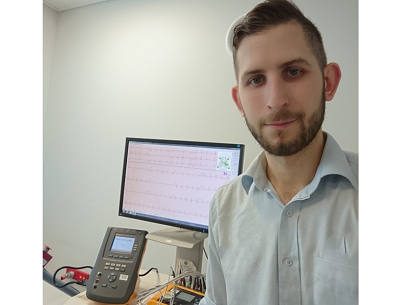
From that apprenticeship, Ryan was granted a trade qualification in Electronics and Communications. Now equipped with expanded electronic knowledge, he found employment within the biomedical industry. His work now saw him repairing, maintaining, and installing medical equipment.
Answering why he chose the engineering industry, Ryan said, “I pursued a career in the engineering industry to satisfy my curiosity for technology and problem solving. It’s incredibly fullfilling to be a part of something that benefits the wider community, and I love seeing a challening project come to successful fruition.”
Working in the biomedical field sparked Ryan’s curiosity even further, soon enrolling for the 52705WA - Advanced Diploma of Biomedical Engineering through EIT.
“I chose biomedical engineering to compliment my background in electronics and further understand how technology interplays with anatomy and physiology. The course impacted the way I interact with clinical stuff, empowering me to confidently understand the medical lexicon. I gained a higher appreciation for the devices I work with and their impact on people’s lives.”
His daily responsibilities include installation, repair, and servicing of medical devices in the fields of invasive and diagnostic cardiology, anesthesia, ultrasound, patient monitoring, and maternal-infant care. He is responsible for ensuring new systems are installed to Australian and global standards before clinical use. After installations have been done, he has to ensure those machines keep on functioning — which includes preventative maintenance and corrective repairs.
Life after EIT
Ryan is now actively building on his skills set within the biomedical sector. He has started an Associate Degree in Science, focusing on biological and information technology.
“I have an elevated level of confidence in my day-to-day work life, thanks to my qualifications. It’s opened up various avenues for my career and inspired me to continue studying in the biomedical sciences field.”
Ryan says that employers have reacted positively to his qualification from EIT. He says it has increased his visibility in the biomedical field and has opened various avenues for his career progression. EIT’s novel online training methodology allows students to progress in their careers while also gaining their qualifications.
When he is not busy at work in his engineering role, he fills his spare time with being an engineering hobbyist, keeping fit and reading. He says he enjoys designing PCBs for audio devices, long distance running and his favorite author is Dostoevsky.
When asked if he would recommend a career in science, technology, engineering, or mathematics to young people, Ryan said, “Absolutely! Technology is constantly changing. A career in these fields keeps your mind constantly engaged and developing new skills and knowledge.”
Thanks to the qualification from EIT, and his appetite for continued studying, Ryan’s career prospects are looking brighter and brighter. It seems that the biomedical industry has inspired him to continue trying to utilize technology to make people’s lives better. When asked about how he sees his career maturing in the upcoming years, he said:
“In the upcoming years, I see myself involved in training and development in the biomedical field. One thing I love about learning things is being able to pass that knowledge on. Teaching and development is a strong way to reinforce your own learning and constantly keep yourself in check.”
Tesla has officially announced that its lithium-ion home batteries, named the Powerwall, will be available in South Africa in 2020.
They have sent surveys to prospective South African customers inquiring about their home energy usage.
The questions the company put to the eager respondents were:
- Do you have a Solar PV system currently installed at this property?
- Do you own this property?
- When would you like the installation to occur? (Within six months or 6-12 months)
- Why do you want to install Powerwall or Solar Panels?

Tesla will send this feedback to a Certified Third Party Installer company who will make contact with the customer. This means there are companies with electrical engineers in South Africa, who are ready to install the solar panel arrays and the Powerwall.
Therefore, future electrical engineers in South Africa should be learning the tools of the renewables trade so that they, too, can find employment in the industry as it is set to blossom.
The consumer solar photovoltaic industry has been stymied for quite some time in South Africa. However, due to ongoing electricity load shedding in the country by the state utility, renewable energy is gaining in popularity.
According to My Broadband, a company named Rubicon is one of the companies importing the Powerwall to South Africa. They confirmed the pricing for South Africans to be:
- Powerwall: R120,000 (USD $8,203.92)
- Backup Gateway: R19,900 (USD $1,360.46)
- Installation cost: R10,000 to R15,000 (USD $683.65 to USD $1,025.48)
Those in rural areas of South Africa can expect to pay significantly more in installation costs. Nonetheless, the availability of the Powerwalls to metropolitan areas in South Africa is a positive step in the right direction for a country urgently seeking to create and store electricity, powered by the African sun.
Powerwall 2, the second iteration of the Powerwall technology, can provide a consumer 13.5kWh of stored energy ready to use. It is a fully integrated AC battery system for residential or light commercial use.
To solve South Africa’s energy crisis, however, more solar companies are having to throw their hats in the ring. Lamo Solar has highly impressed the President of South Africa, Cyril Ramaphosa. The President, at a recent investment conference, acknowledged the work the solar company is doing and encouraged more small and medium-sized enterprises to enter the renewable energy space.
South Africa is looking for innovative solutions to bringing electricity to the masses in 2020, as the government figures out what to do with the ailing state utility. President Ramaphosa has indicated that he wants to attract the likes of Elon Musk to South Africa so they can bring with them their innovative engineering technologies.
With the changing landscape of electrical engineering, engineers must continue learning and developing their skills.
The Engineering Institute of Technology (EIT) is one of the only institutes in the world specializing in engineering. Through our unique online delivery model, students can study with us from anywhere in the world, to continue their education while maintaining work and family commitments.
EIT offers several electrical engineering programs at different levels, from professional development, through to vocational education and training, and higher education.
Works Cited
Musk, Elon. “Would Love to, but Import Duties Are Extremely High, Even for Electric Vehicles.” Twitter, Twitter, 28 Aug. 2019, twitter.com/elonmusk/status/1166854343770988544?ref_src=twsrc^tfw|twcamp^tweetembed|twterm^1166854343770988544&ref_url=https://businesstech.co.za/news/technology/338275/elon-musk-on-why-tesla-is-not-in-south-africa/.
Vermeulen, Jan. “Tesla Powerwall Is Back in South Africa.” MyBroadband, 2 Dec. 2019, mybroadband.co.za/news/energy/328955-tesla-powerwall-is-back-in-south-africa.html.
Air travel is a major contributor to CO2 emissions and is attracting the ire of environmentalist movements who are campaigning for the industry to look to alternative methods of powering aircraft.
Airbus is looking to nature for inspiration to minimize the carbon footprint their planes create around the world. They are suggesting that planes could fly in V-shape formations — as seen by geese migrations in the animal kingdom — to save fuel and lower emissions.

In the first six months of 2020, Airbus hopes to test the flying formations with two A320 planes. The planes will fly a predetermined route in a configuration that will test the aircraft’s ability to utilize what is known as ‘wake energy retrieval.’
On their website, Airbus writes, “Just like birds, every aircraft creates a wake while flying. Flying together could thus help aircraft to retrieve the lost kinetic energy by positioning a follower aircraft in the air upwash of one of the lead aircraft wakes. Airbus is taking a fresh look at how this flight technique could provide aircraft with free lift, enabling them to reduce engine thrust and fuel consumption.”
Airbus says that air traffic management technology has experienced a leap forward. Historically, the air traffic management tech would have been unable to aptly monitor two planes flying so close together, but Airbus says the technology is now more than capable. The flight engineers at Airbus will be engineering around the idea and demonstrating the company’s proficiency, under a project named Fello’fly.
Airbus says that by flying planes 3km apart from each other, the aircraft can benefit from the wake retrieval energy, which can equate to 5 to 10% less fuel and emissions. The prohibitive factor that could delay this innovative step is collaboration across the industry as a whole. Getting all aircraft companies coordinated and collaborating could be tough.
Nick Macdonald, Fello’fly Demonstrator Leader in a press release, said, “To achieve this evolutionary step in operations, we have to look at the challenge from the perspective of all industry stakeholders. It’s a great opportunity for our industry to demonstrate a joint commitment to reducing our use of fossil fuels.”
Hydrogen-powered aircraft coming soon?
The aviation engineering industry has been around long enough for it to, in a way, return to its roots. Now with the means to meet the zero carbon propulsion vision of the future, the industry is considering a shift back to hydrogen as a potential fuel source.
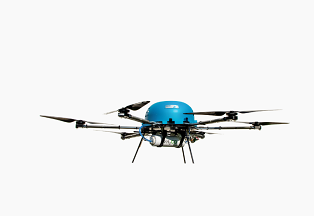
An engineering team at Imperial College in London has patented a hydrogen storage solution they believe could be implemented in the air travel industry. They are calling it H2Go Power.
Co-Founder and Director of H2Go Power, Dr. Enass Abo-Hamed, initially began work on the technology at the department of chemistry at the University of Cambridge.
“We have developed through the past two years a safe method for hydrogen production and storage for providing power on the movie. Our core technology involves a novel porous catalytic material, which produces, stores and releases hydrogen in a controlled manner. Our unique solution allows for the deployment of Fuel Cells into new markets, such as portable consumer electronics. The potential outcomes include smartphones that last 5x longer than ones that have current battery technology and all-electric vehicles with the same range as combustion engine counterpart.”
The company has subsequently begun working on powering drones with hydrogen fuel cells. The company’s systems work by converting the hydrogen gas into a solid-state, which makes storing the gas that much safer. It is stored in a specially designed 3D-printed tank. Inside the tank are a network of aluminium tubes.
Through one side of the reactor Hydrogen (H2) is pumped through a catalyst, freeing electrons and, in turn, generating the electricity. On the other side, oxygen (O) is pumped in and fuses with the positively-charged hydrogen atoms. The only emission that the process creates is water.
The UK government and the EU are injecting money into the company to continue to develop the fuel cells. Dr. Enass Abo-Hamed said:
“While it takes hours to recharge a lithium-ion battery-powered drone, it could take minutes to do that with hydrogen. Maybe in the next 20 or 30 years, we could even start thinking about how to put this in commercial flights and decarbonize air travel — which is very important for our climate.”
Works Cited
Airbus. “Airlines Are Looking to Reduce Fuel Consumption. Wake-Energy Retrieval Could Help.” Airbus, Airbus, 18 Nov. 2019, www.airbus.com/newsroom/stories/airlines-are-looking-to-reduce-fuel-consumption-wake-energy-retrieval-could-help.html.
“Pioneering Clean Tech. Delivering Safe and Reliable Power Supply for All.” H2GO Power, www.h2gopower.com/.
Jules Bekoka Botomba’s story is an inspiring one. He is an Engineering Institute of Technology graduate who, despite the odds, managed to bring himself out of a difficult situation and turn it into success in the automation world.
He has obtained two qualifications with EIT.
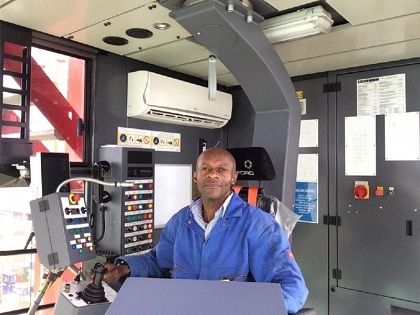
During the Second Congo War in 2001, Jules and his family had to escape the country, effectively becoming refugees. Jules fled, looking for asylum in Johannesburg, the largest city in South Africa. Coming from the DRC, Jules was predominantly French-speaking. He soon found he would have to learn English to communicate with the South Africans.
Jules realized it was going to be tougher to assimilate to South African customs than he initially thought. Asylum seekers who were waiting to be recognized as refugees were not permitted to study or work in the country.
This set Jules — a man who fantasized about having a career in engineering since he was a young boy — considerably back. The prohibitive legislation was only repealed in 2003, but, finally he could get a job. Equipped with only a matric certificate from the DRC, he went to Cape Town to try and find a job. So began his journey to develop his skills so that one day, he could be recognized as an engineer.
Jules bought a newspaper and checked the classifieds, eventually finding an ‘electrician wanted’ position. Without even knowing how to pronounce the English words in the electrical industry, Jules went to the interview for the job. He soon found out that he was to be challenged. The interview for the job consisted of having to fix 100 broken fluorescent light fittings — of which he managed to fix 60.
The employers were impressed, and he got the job with MetroRail Limited, where he worked from 2004 to 2006. In this time, he did an associate’s degree in electrical, electronic, and communications engineering technology through Intec College in South Africa.
Moving from Cape Town to KwaZulu-Natal saw Jules working for Bidvest Logistics as a Technician working from 2006 to 2007.
This is where he came into contact with programmable logic controllers, human-machine interfaces, and general automation technologies. When he began working on these technologies, he knew that in the future, everything would become automated, and if he did not focus on improving his technical know-how in automation, he would be left behind.
Jules then secured his dream job, working as a Port Automation and Control System Engineer with the Liebherr Group. They were working with the KwaZulu-Natal government to expand the piers at the port of Durban. On this job, he met a handful of engineers that reinforced the idea in Jules’ head that automation was taking over the industry. The project that the Liebherr Group did for the government of KwaZulu-Natal helped grow the economy of the region in the seven years they worked on the project.
To further build on his knowledge in automation, Jules enrolled for the 52677WA - Advanced Diploma of Remote Engineering, Mechatronics and Robotics with the Engineering Institute of Technology.
In 2015, Jules decided to look for employment outside of South Africa. This saw Jules working on ports up the coast of West Africa, namely in Nigeria and Togo.
However, he had a feeling that his true engineering potential could be realized in the United States. He began working for Interplex Automation, ArcelorMittal, and finally ended up in his current role.
Jules now works as a Lead Software Design Engineer in PACCAR — a leading truck manufacturing company in Texas. The company produces 190 trucks every 8 hours, and Jules is in charge of making the manufacturing process as efficient as possible.
Jules Bekoka Batomba is a shining example of how to overcome obstacles to get to where you need to be. Arriving in South Africa with nothing to his name but a matriculation certificate, Jules managed to elevate himself thanks to a brilliant work ethic and a hunger for knowledge — specifically in the automation world. The result is a worker who will continue to thrive in the fourth industrial revolution as the world continues to automate and transform the job markets.
Jules has recently graduated again with his Master of Engineering (Industrial Automation) from the Engineering Institute of Technology. He is now pursuing a master’s degree in robotics through the Ancestor Polytechnic Institute. There is no stopping Jules now — he has become what he always dreamed of as a young boy: a fully qualified engineer.
It is no exaggeration to say that technology has taken a giant leap forward in the last decade.
In this decade, Uber revolutionized taxi industries around the globe, 4G networks brought fast internet to the masses, and Whatsapp and Instagram appeared on the world stage.
Who do we have to thank for these incredible contributions to daily life? Engineers, in part.
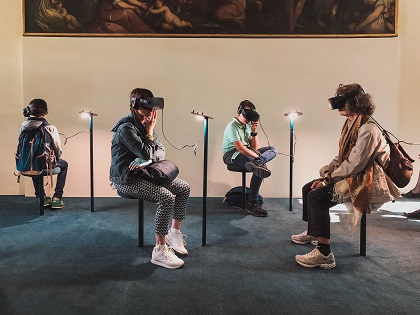
The arrival of those advents of technology proves that the next decade could be equally as disruptive in the world of engineering. These technologies have sent the dominoes falling in the industry, revolutionizing how we all do business, mobility, learning, networking, and automating.
Naturally, engineers are philosophizing of what could be the next big thing that transforms industry across the world.
Artificial intelligence and self-driving cars are the buzzwords flying around at the moment. However, we could ask: What other engineering innovations could be hiding in plain sight, just waiting for a business plan to set them in motion?
The most recent addition of the Fourth Industrial Revolution is 5G networks — which have speed capabilities set to make the work that both humans and machines do more efficient. 5G mobile internet speeds range from about 50Mbit/s to over a gigabit. It is now leading to the development of smart cities by increasing the rate of interconnectivity.
The speed of 5G is making virtual and augmented reality simulation technologies a physical reality.
The development around simulation technologies and the transformations of the online and on-campus training industry is what the Engineering Institute of Technology is interested in monitoring.
Extended reality
Extended reality can be loosely described as the development of immersive technologies that combine both physical and virtual worlds. Experts expect that the next decade of technological development will create incredible opportunities in the extended reality space.
Immersive experiences have the unique ability to teach. This way, extended reality systems could train the world’s future engineers. Through a smartphone, glasses, or tablet, augmented reality systems can display virtual information and images on top of the real world.
Augmented realities can help engineers display machinery on a factory floor before it has even been purchased or installed, to determine what the end product might look like. It could also simulate end products in the real world when the product has not been manufactured yet.
In virtual reality, engineers can see the inside of a building or bridge construction where, in the real world, a brick or piece of steel has not yet been laid. The virtual reality world is a world entirely made up of computer-generated graphics. It can be used to simulate technologies engineers may see in the field, and help engineers learn how to operate integral machinery before doing the job in the area. It gives the engineer a 360-degree view of a simulated environment. The training and learning opportunities with this technology are innumerable.
Mixed reality is where the worlds of augmented and virtual reality come together. Microsoft’s head-mounted Hololens integrates 3D virtual elements and superimposes them into and all around the real world.
One of the bigger players in the extended reality space is American multinational semiconductor and telecommunications equipment company Qualcomm. In December 2019, the company announced the launch of its XR2 platform. They are calling it the ‘world’s first 5G-supported extended reality (XR) platform’, running off their specially designed Snapdragon chipsets.
The company is collaborating with Niantic Labs, who brought the world Pokemon Go and, more recently, Harry Potter: Wizards Unite. On their announcement of the collaboration with Qualcomm, they write:
“At Niantic, we’re unlocking the potential to create next generation AR experiences through the Niantic Real World Platform, and building new ways to map, share entirely and understand reality. The Niantic Real-World platform has been proven out by hundreds of millions of users…”
The Engineering Institute of Technology will continue to monitor the development of these extended reality technologies. The future of education and training with the 5G internet speeds — and technologies that can make the most of those speeds, like extended reality applications — is generating immense opportunity to continue training and educating engineers who, in turn, create a better world for all humankind.
What do you think the next technological leap forward will be?
Gerrit Botha is an engineering professional currently working in the automotive, brewing, and mass manufacturing industries. He is also an Engineering Institute of Technology graduate. Once he completes his current studies, he would have undertaken four courses with EIT.
He obtained his Professional Certificate of Competency in Allen Bradley Controllogix/Logix5000 PLC Platforms in May 2016. He followed that up with a Professional Certificate of Competency in Instrumentation, Automation and Process Control, in 2017. After that, he earned his 52677WA - Advanced Diploma in Remote Engineering, Mechatronics and Robotics in July 2017. He is now working through the 52708WA - Advanced Diploma in Industrial Automation.
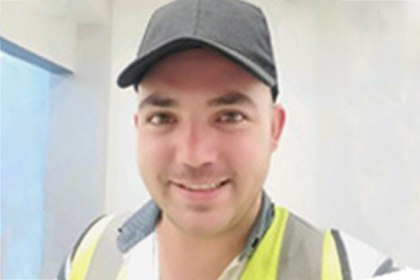
Gerrit’s engineering career, while impressive looking — based on how many qualifications he has amassed — has been filled with ups and downs. His journey reveals how one can both be a student of engineering and life. His love for engineering stems from his childhood days.
“I have always been fascinated by how things work,” he said.
“Even when I was young, I was more intrigued by taking apart and investigating my radio controlled car than I was with actually playing with it. This curiosity just never left me and that’s why engineering was a natural choice.”
Further enhancing his love for engineering was spending time in his father’s engineering workshop. His father serviced the structural steel and earthmoving machinery market. One of the first artisanal skills Gerrit learned was the operating of milling machines and lathes. On weekends, he had a part-time job rewiring trucks and earthmoving machinery.
As a hobby, Gerrit busied himself with learning programming. He also had a knack for mechanical and electrical machine setups. He was a proverbial kid in a candy store when it came to exploring technologies. When the time came for him to decide what he was going to do in terms of tertiary studies, he chose mechatronics. However, his life then changed significantly.
“Unfortunately, at the beginning of my final year of school in 2012, my father passed away unexpectedly. This put heavy financial strains on our family as my father was the main provider. So, I decided to put the studies on hold in pursuit of employment to support my mother and our family financially”.
Employed... but ready for more
Gerrit managed to secure a job in construction engineering management in the petrochemical industry. There, he learned how to refurbish hazardous chemical vessels. He specifically became familiar with the Safety, Health, Environment, and Quality (SHEQ) engineering ideologies. During his time in that role, he formed part of 4 vessel projects and acquired numerous health and safety qualifications.
This allowed him to take care of himself and his family financially. He concluded that he should finally get back to his studies.
“Unfortunately, in this ever-innovating and expanding engineering discipline that is mechatronics, I could not go back to my old varsity as the curriculum had a substantial facelift. Nonetheless, with my busy lifestyle, I knew I needed to find a varsity that could offer me a program that is flexible and via correspondence. Finally, I came across EIT.”
To familiarize himself with the online method of study EIT presented him, he decided to do two short professional development courses. Soon he knew he wanted to continue. He was ready to pick up his mechatronics once more, and that’s when he enrolled in the Advanced Diploma in Remote Engineering, Mechatronics and Robotics.
Career change
Gerrit changed careers during his studies with EIT. He went to go and work in an environment where he could learn more about the world of PLC programming by fulfilling a role in the beverage brewing industry. He was soon promoted to a project engineer after only two months at the company — all thanks to his project management and leadership skills.
Twelve months later, he was the engineering manager of the company. He introduced some cost-saving initiatives within the company at the manufacturing level. He has since started the Advanced Diploma in Industrial Automation with EIT and is aiming to complete a Master of Business Administration when he completes the program.
EIT proved to be the best fit for Gerrit. Life threw its fair share of curveballs his way, but he emerged victorious. He managed to equip himself with both theoretical and practical knowledge and become a fully-fledged engineering professional.
But, Gerrit has learned that the education of life and engineering seldom ever end.
“The more I study, the more I find out how little I actually know. It’s exciting to be part of this growing organism called engineering - and I continue studying so that I am on the top of my game,” he said.
“I love engineering and the ever-expanding organism it represents. My short career has been filled with more challenges than the norm, but it has taught me that there is always a way to change your situation. You just have to be willing to take the first step and, of course, have patience. As the famous saying goes: ‘Rome was not built in a day.’”
Dear Colleagues,
As I was cycling into work this hot morning — forty degrees today —I was thinking about four incredible laws that we frequently use in engineering. Many of you would be familiar with them, but I see them come up so many times that I would thought I would revisit them.
The First Law: When there is any doubt, there is no doubt.
(Courtesy of the actor, Robert De Niro, I believe).
If you are contemplating a structure, such as a support, and are worried about some evidence of corrosion weakening it, you would be virtually guaranteed that there is a problem with the structure because of corrosion. I notice that in a major bridge collapse in Johannesburg, there were some questions asked during the construction about the efficacy of the support, but no one applied this Law. It could have saved lives and avoided injuries if people had been more critical and acted on their doubts.
Another example (from personal experience); you are testing some software for a power station control system, which, when switched onto the grid, will be providing critical power to a town. If you are a little concerned that there may be some unexplained glitches with the software, well — you know for sure — that these glitches will appear as you put the power station onto the grid. You would drop the power to the town unless you test the software meticulously and fix these bugs.
So, if there is any element of doubt in a design or in troubleshooting a situation, you are guaranteed that your worse fears will be realized if are you aren’t proactive. Presumably, this law is related to Murphy’s Law.

The Second Law: the KISS Principle
As most of you unerringly know, this means Keep it Simple Stupid. When building something or interfacing with people — simplicity is the best (and a great example of this is Steve Jobs’ initial work with the Apple iPhone).
Oddly enough, engineering professionals often are so overwhelmed with a design or project — probably because many other stakeholders are wanting to provide their input — that they forget it. And one ends up with a horribly complicated design or interface with people.
This is also related to the simplicity principle, traditionally referred to as Occam’s razor, which is the idea that simpler explanations of observations should be preferred to more complex ones.
The Third Law: The Law of Unexpected Consequences
This was illustrated to me many years ago. Traffic police — in Portland, Oregon, I believe — were puzzled by the increase in accidents after all the traffic lights in the town had been upgraded with the most reliable super duper LEDs. These were supposed to provide greater reliability and a sharper, more intense light.
However, the LEDs are very efficient and therefore do not waste their energy in heat (as per the older incandescent traffic lights which were hot to the touch).
The Law of Unexpected Consequences came into play, as despite an improvement in the new traffic lights operation, reliability, and quality of lighting, they did not melt the snow, which built up during winter. This obscured the lights to the oncoming traffic. The older incandescent lights melted the snow build up around them because they were hot – thus giving a clear light to oncoming traffic.
So any design changes you make often have some consequences you may not think of. Try and always think laterally about other issues that may result from the changes you put in place.
The final law is Newton’s Third Law: The Law that for every action, there is an equal and opposite reaction. As engineers, you would be hyper familiar with this law; but I believe it also applies to any activity you undertake — there is always resistance against an initiative (perhaps inertia). For example, if you decide to change a particular software design program to something which you believe is more efficient — you will unleash a torrent of abuse and disinterest in moving over — no matter how useful and improved the new software is.
The trick is always to get buy-in from all players and to educate them gradually to get them on board and supportive of the changeover or initiative.
Finally, I always love this quotation: A common mistake that people make when trying to design something completely foolproof is to underestimate the ingenuity of complete fools.
Yours in engineering learning
Steve
Mackay’s Musings – 4th December’19 #689
The Fourth Industrial Revolution has had a significant impact on the worlds of education and work. The advent of the internet and its subsequent development over the last three decades has led to immense changes and has produced incredible technological leaps. The interconnectivity of internet-connected technologies has dually given rise to the Internet of Things. This has meant that a plethora of technologies are now online: household appliances, houses themselves, laptops, smartphones, watches, virtual reality headsets, and virtual assistants.
The development of mobile internet-connected technologies has not only revolutionized consumer technologies, but it has also created a seismic shift in the ideologies that underpin education. The methodology behind remote, online education and training is an ongoing process with the goalposts constantly shifting in the industry.
The focus of the last couple of years in the online education and training space has been on simulation - which has also led to gamification. Gamification is used as a strategy of teaching that relies on creating playable games that teach real-world principles. Simulating engineering problems in gamification environments is particularly helpful for learning practical skills that can be applied in the workplace.
The CEO of Simutech Multimedia, Samer Forzley, recently delivered a presentation at the Process Expo at McCormick Place in Chicago. He convinced crowds that manufacturing floor staff could be taught via playable, simulated engineering games. His presentation was entitled ‘Digitally Developing the Next Generation of Manufacturers with Gamification and 3-D Simulation’. The company has created a point-and-click game that displays a real-life engineering simulation of a manufacturing floor.
Forzley says that the teaching methods that worked for one generation will not work for the next one. He says that Generation X, and their predecessors, the Baby Boomers, learn through memorization and mentoring, otherwise known as a traditional schooling environment. Once these students get to the manufacturing floor, they would receive additional training from staff already employed at the factory. However, he says that the teaching methods of the past are failing to hit the mark with Millennials and Generation Z.
Therefore, simulated virtual environments and gamified engineering problem solving is the new way forward for a generation of people who have grown up in the interconnected internet age. It is also a great way to gain continued professional development and attain new skills and knowledge in different areas of engineering.
The Engineering Institute of Technology (EIT) is an Australian institution that specializes in engineering education and delivers professional development and accredited programs to students worldwide. We use a unique online delivery methodology that makes use of live and interactive webinars, expert lecturers, dedicated learning support officers, and state-of-the-art technologies.
One such technology is our online laboratories and simulation software. They can be accessed by students around the world to simulate engineering scenarios and enhance applied skills and knowledge, so they graduate job-ready.
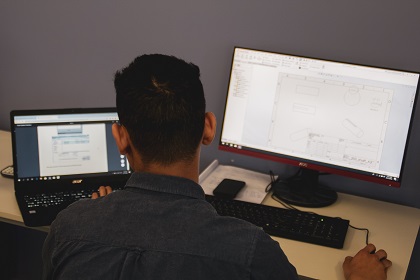
Students can control and interface with a pneumatic circuit using a microcontroller, for example. There are also labs involving field instruments; they include data acquisition, pumps, motors, industrial modems, and routers. Sensors can also be accessed, including flowmeters, ultrasonic sensors, oscilloscopes, and temperature gauges.
However, students learning online also require some real-world practical examples of how engineering workplaces function and what problem-solving scenarios may arise during their employment. Therefore, students can benefit from a process plant simulation that simulates both the operator and field technician roles.
Using plant simulation software, students can ‘walk’ through an industrial plant, tune a process loop, or diagnose a fault. Equipped with the knowledge learned in the virtual-practical world, the students can safely go into their workplaces knowing how to control the technology on-site.
The simulation kits range from compressors, pumps, distillation columns, heaters, and boilers. And they are realistic. With diagnostic tools rapidly becoming internet-based, these simulations are very closely aligned with real-world plants.
Works Cited
Wpengine. “Control Engineering Magazine.” Control Engineering, www.controleng.com/magazine/.
Starting from 2020, 4 March will now be the World Engineering Day for Sustainable Development as designated by the World Federation of Engineering Organizations (WFEO). Previously known as ‘Engineer’s Day’, the celebration was formerly observed in several counties on various dates throughout the year.
The announcement was made on November 20th at the 2019 World Engineers Convention by WFEO President, Dr Marlene Kanga.
The WFEO is one of the biggest engineering collectives in the world, bringing together national engineering organizations from over 90 nations and represents around 20 million engineers worldwide. The federation was founded on March 4th 1968, making the new date for World Engineering Day an obvious choice.

The resolution to get the day officially recognized as the World Engineering Day for Sustainable Development was adopted at the 206th UNESCO Executive Board session. It was decided on that day in April to set the announcement for the World Engineers Convention of 2019.
The WFEO has also defined the main topics the day will aim to recognize and celebrate. The goals of World Engineering Day have been outlined as:
- To demonstrate the role of engineers and engineering
- To develop solutions to climate change.
- To raise the profile of engineering and technology, and its role in improving the quality of life worldwide, and achieving the UN Sustainable Development Goals.
- To encourage dialogue between engineers and decision makers, industry leaders, scientists, non-governmental organizations and the public at large on issues relating to climate change and sustainable development.
- To enable policies and solutions to address the world’s most pressing problems using engineering and improve dialogue between citizens, engineers and policy-makers.
- To encourage, more young people, especially girls, to consider engineering as a career.
“Engineers are often not very good at articulating the value of what we do for society. That’s a problem, because engineering is critical to achieving the UN Sustainable Development Goals” said Dr Kanga, during her opening address at the World Engineers Convention.
“As we all face the impacts of climate change, environmental crises, our growing cities like artificial intelligence, we’re going to need more engineers.”
It was particularly developing countries that were pushing forward hard for the 4th of March to be recognized worldwide. UNESCO representatives from the Republic of Namibia were instrumental in putting together documentation that was used to introduce the motion to recognize World Engineering Day to the board.
Ambassador Albert Aochamub, Namibia’s permanent delegate to UNESCO’s 296th executive board meeting, introduced the resolution. The country believes that engineers play a pivotal role in a nation that needs engineering solutions to infrastructural and societal problems. Other countries that considerably supported the motion were China, Nigeria, France and the United Kingdom.
The World Engineering Day for Sustainable Development is part of UNESCO and WFEO’s engineering goals for 2030. The focus is to bring more people into engineering education and develop engineering solutions for countries to breed nation building. For the life changing work engineers do in a calendar year, now they can wake on the 4th of March knowing that their work is valued and that they are an integral piece to the puzzle of their societies wherever they are placed.
Works Cited
“From next Year, the World Will Finally Have a Day to Celebrate Engineering.” Create, 20 Nov. 2019, www.createdigital.org.au/world-day-celebrate-engineering/.
“World Engineering Day for Sustainable Development.” WFEO, www.wfeo.org/world-engineering-day-for-sustainable-development/.
Just after returning from presenting a round of seminars in Asia (in India, Nepal and Sri Lanka), Steve Mackay landed in Melbourne on the evening of the 26th November, with three colleagues, for the TEQSA Conference.
The theme at the conference this year was Partnerships driving Quality – a topic close to our hearts: in essence, as educators, we partner with our students. One of our Master students, Santosh Ghimire, based at our campus in Melbourne, attended the conference as EIT’s student representative.
Another important partnership, which helps us drive quality, is the one we have with industry. We engage practicing engineers to guide us in the design of our course content and experienced engineers from around the world instruct and lecture for us. Furthermore, our students complete internships in engineering industries and ultimately our graduates work within them.
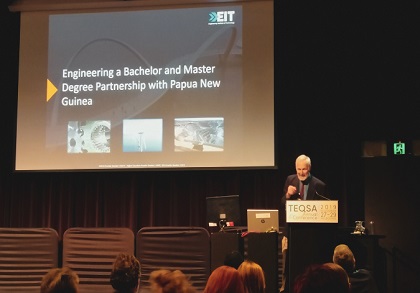
Steve Mackay and our Resources Manager, Danielle Techera, presented at the conference. Danielle’s presentation described the importance of that collaboration with industry, with her focus on its contribution to the creation of our academic resources for students; resources that are relevant, practical and prepare students for real work in their fields of engineering.
Her presentation also described why our materials are designed in-house – rather than relying on individual lecturers for content. Our platform of learning is multi-modal and therefore more complex; a number of lecturers are often involved in teaching a single unit - in higher education, or a single module - in a vocational course. We use industry to design and drive the content, but by creating the resources in-house we can guarantee that the materials are consistent and equivalent across the delivery platforms. It also ensures that our materials are continuously improved; an increasing necessity as engineering becomes more reliant on changing technologies.
Steve spoke briefly about the challenges EIT is facing with transnational education. Towards the end of 2018 an exciting opportunity arose: to work with PNG partners and offer engineering degrees to school leavers. (Engineering graduates are critical to the resources projects that run in the country.) A number of hurdles have presented themselves, however, including some political challenges, but Steve likes nothing more than a challenge. It is likely that his persistence will result in positive partnerships across the Arafura and Coral Seas before long. And more importantly, celebrate the graduation of students who will enjoy fulfilling careers in engineering in PNG.
The conference was an important opportunity to network with the TEQSA team and attendees from across the education industry in Australia. It also gave everyone an opportunity to debate, learn and contribute to issues that are critical in the sector. Some of the topics were very positive, for instance: Creating a Sustainable Culture of Scholarship, and one with which we at EIT staunchly agree: Knowledge as the Key to connecting the Vocational and Higher Education Sectors.
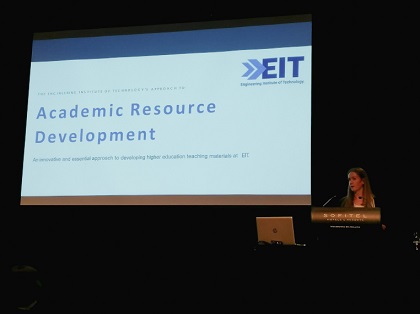
Some of the more dispiriting and threatening issues in education were also broached; for instance how academic integrity is being undermined by contract cheating. The profound extent and impact of unethical businesses which facilitate these dishonest practices was confronting to hear. Thankfully, with its vibrant and established online platform, EIT is prepared and a little ahead in this ‘game’. Our IRIS software (Intelligent Remote Invigilation System) has frustrated many students, just when they thought that ‘a leg-up’ would save them some time and effort!
The conference certainly provided grist to the mill for those who attended and was a fitting end to another successful and eventful academic year at the Engineering Institute of Technology.
We would like to acknowledge the creative and hard work of the incredible EIT teams of academics and administrators scattered globally. And to our wonderful students, past, present and future - based in all corners of the world - we wish you everything of the best as 2019 draws to a close. We thank you all for your support.
Engineers at the University of Rochester in New York are working to develop “unsinkable” materials. Once perfected, these metals could be used to build unsinkable ships, create puncture-proof life jackets, and protect electronics from water damage.
The work is being conducted in the Femtosecond Laser Laboratory at the university. The researchers have been making metals superhydrophobic by utilizing femtosecond lasers.
Femtosecond lasers are traditionally used in cataract surgery. The laser is used to cut patterns into a surface at the nanoscale — in this case, into a metallic structure. The result is a surface that can trap air bubbles.
The researchers put together two aluminum plates facing inward with just enough space in between them to trap the minimum amount of air needed to float. But that’s only half the battle.

Trapping air bubbles is only a short term solution, and after a while, the structure will sink. Researchers have been looking for a way to enable the metals to float for prolonged periods.
The researchers have now turned to nature for inspiration, and have been studying argyroneta aquatic spiders and fire ants. The spiders spin underwater dome-shaped webs that they fill with air using their legs and abdomens. Fire ants band together with their superhydrophobic bodies to create a ‘raft’ that floats above the water.
The work is spearheaded by Professor Chunlei Guo, a professor of optics and physics at the University of Rochester. The researchers published a report in ACS Applied Materials & Interfaces. They report that even when damaged, the pattern-etched metal can continue to float:
“The assembly shows an unprecedented floating ability; it can float back to surface even after being forced submerging underwater for months. More strikingly, the assembly maintains its floating ability even after severe damage and piercing in stark contrast to conventional watercraft and aquatic devices. The potential use of the SH floating metallic assembly ranges from floating devices and electronic equipment protection to highly floatable ships and vessels.”
The space in between the aluminum plates creates a watertight compartment. Along with the air-trapping laser-etched pattern, the result is a superhydrophobic metal - meaning it repels any liquid that touches it. The effect created is quite something to behold, as can be seen in this video:
This work could have some incredible consequences for engineering industries in the future. The researchers conducted a test where they forced their metal underwater for two months in perpetuity. After two months they planned to release the weight atop the metal to see if the metal would sink, but to their surprise, the metal was as buoyant as ever.
Works Cited
“Highly Floatable Superhydrophobic Metallic Assembly for Aquatic Applications.” ACS Applied Materials & Interfaces, pubs.acs.org/doi/10.1021/acsami.9b15540.
Linder, Courtney. “Unsinkable Metal Could Lead to Unsinkable Ships. Now Where Have We Heard That Before?” Popular Mechanics, Popular Mechanics, 7 Nov. 2019, www.popularmechanics.com/technology/design/a29724303/unsinkable-metal-ships/.
“I would like to use my experience as an inspiration for current students as well as those contemplating enrolling for online classes. Studying while working is no easy task, but with the right counsel and advice from someone who has gone through the process, it can be a big drive for those experiencing the same.”
Mildred Nanono completed her Master of Engineering (Industrial Automation) through EIT, and we are proud to announce she is our Student Ambassador for 2020.
Studying online from Uganda while working full-time as an electrical engineer presented some challenges; however, Mildred says that EIT’s unique delivery model made it achievable even on her busiest days.
“The online studying experience was remarkable for very busy employees like myself. At the time of studying, I was engaged in big projects back home. The online classes allowed me to carry my class everywhere I went, even on days away from home, during factory acceptance tests in other countries.

“During my time, there were two study sessions for each lecture — this created flexibility for my busy schedule. Additionally, during the busiest of days, it allowed for submission of a summary report in the event I missed both sessions, making attendance score achievable in a busy world.”
In addition to the flexible study options, Mildred also commented on the support she received throughout the program, from the application process through to submitting her thesis.
“Applying for my course was very smooth. The learning support officers were readily available for support. Communication was timely and on point.
“My supervisor for the thesis was very constructive and instrumental during the entire process of my thesis development and completion.”
EIT is one of the only institutes in the world specializing in engineering. As a result, our lecturers have applied knowledge, which they impart to ensure our students graduate job-ready. Given the majority of our students are already employed in the engineering industry, our classes allow you to form global contacts and learn from each other.
“My class had experienced students who had worked with distributed control systems. Likewise, the lecturers not only had the theory but also loads of practical experience.
“Particularly, during my last year of study, I was reviewing the designs for the upgrade of our distributed control system, and my lecturers helped to come up with the best solution. Coincidentally, the modules I covered that semester related closely with my work. The online laboratories were exceptional. I never felt the need to travel to Australia.”
While Mildred tells us she did become somewhat scarce during her studies as her focus was on work, attending classes, completing coursework, and preparing for exams, she says the knowledge and skills she gained from the degree made it all worthwhile in the end. Since completing her degree, she has taken a job as a control and instrumentation engineer.
“My employer appreciated the study model, as I was never absent from duty, and I have grown tremendously in my career as the current control and instrumentation engineer. As such, my employer has agreed to sponsor my colleague for the same course.”
She tells us that the next career objective she hopes to achieve is a management role, and she will be undertaking the Engineering Leadership professional development course with EIT’s sister company, IDC Technologies, to help her gain further skills and knowledge in this area. We wish her all the best in her career.
If you would like to contact Mildred to learn more about the student experience at EIT, you can email her at
Imagineer.
Verb.
Gerund or present participle: Imagineering
Devise and implement a new or highly imaginative concept or technology.
How do engineers instill a feeling of magic in people’s minds? Some have spent the last 70-years creating innovations that stir up a sense of awe and wonder in anyone who experiences Disney – its theme park has even been dubbed the happiest place on earth.
These engineers have been working creatively in a space that has been described as equal parts design studio, design center, think-tank, and innovation laboratory. This laboratory of innovation is known as Walt Disney’s Imagineering. And the engineers that work there are called Imagineers.
These Imagineers are the fascinating individuals behind the scenes at Disney who invent and design the magical feats that have cemented Disney as one of the greatest entertainment brands in the world.

And the world has never really heard their story, until now. In November, Disney released their streaming video service Disney+, with a documentary on the Imaginers entitled: The Imagineering Story.
The documentary begins by telling the Disney story from 1928 but quickly shifts focus on the building of the first Disneyland in California, which opened in 1955. Bob Iger, the current CEO of Disney, said, “Walt set a standard early on with the Imagineers.
“There was a standard that surprised people, a standard that enabled people to come in expecting something and giving them something even beyond that. Beyond, really, their own imagination. So that they left thinking, ‘wow, either only Disney could do that,’ or asking, ‘how did Disney do that’”.
The inspiration for Disneyland came from Walt Disney’s daughter. Walt took notice of the things his daughter enjoyed as a child and wanted to create a place where parents and their children could have fun together.
The first bit of engineering involved building a model railroad and train in his backyard. From there, he became obsessed with the idea of creating a theme park.
In 1952, Walt Disney formed a group named WED (Walter Elias Disney) Enterprises Inc. to design and build on the growing idea of Disneyland. He recruited creative staff already working for animation divisions within Disney and found other designers to be the first Imagineers.
Walt Disney dared this first intake of Imagineers to bring the abstract notion of Disneyland and turn it into a three-dimensional reality.
Creativity in engineering
Disney purchased land in Anaheim, California, and began seeking funding to build Disneyland. Amusement parks at the time were not raking in business in America. Nonetheless, the construction of the first Disneyland commenced in 1954.
Bob Gurr, an Imagineer and Industrial Designer who worked for Disney from 1955-1991 described the atmosphere of that first stage of construction. “The concept of ‘creative chaos’ is a word that you hear a lot of times, and I just thought it was an absolute marvel of super-organization without being organized. We were able to move so fast; we built it before the Xerox machine was invented. ”
The combination of skills, expertise, and innovation from many different creative individuals formed part of a genuinely innovative engineering team. Those who were involved with the project say that in today’s world, you would find hard-pressed to find an engineering team similar to that of the Imagineers who worked on the first Disneyland.
After blazing through US$17 million — triple the amount of money they planned on spending —the first Disneyland opened its doors on 17 July 1955. Two months later, the one-millionth visitor would walk through the doors. It was a roaring success, and a new era of theme parks had been born. Soon after, Disney began focusing on adding rollercoasters to the theme park. By July 1959, The Matterhorn Bobsleds, the first tubular steel roller coaster in the world, was opened.
More and more innovations would be added to Disneyland through the years as technology advanced. But what they achieved back in the 50s is nothing short of incredible.
However, Disney is not slowing down. They continue to build new attractions at their theme parks and utilize technology to thrill customers. Walt Disney famously said, “Disneyland will never be completed. It will continue to grow as long as there is imagination left in the world. It is something that will never be finished.”
The ideological position on engineering that Disney, as a company, employ, can inspire all other engineers. Creating innovative technologies, and utilizing imagination is something that can break the sometimes tedious engineering process. Creating a unique environment for invention with an atmosphere of childlike imagination is what Disney has thrived on in all the facets of their company. Disney along with the Khan Academy, has also put together a free course that can give you the basics of becoming an Imagineer. You can access it here:
https://www.khanacademy.org/humanities/hass-storytelling/imagineering-in-a-box
Works Cited
Disney, www.disneyplus.com/en-gb/video/a250e541-a085-4b1f-aced-631a2cf88501.
Engineering companies in the United Kingdom are ensuring the engineers of the future engage with engineering through collaboration and innovation. To achieve this, the Royal Academy of Engineering has developed a day to celebrate engineers and their contribution to the world. The day is aptly named: This Is Engineering Day, and it took place on Wednesday, the 6th of November.
“From the shoes you wear and the phone in your hand, through to the music you listen to and the games you play, engineering is at the heart of everything. It brings ideas to life and turns dreams into reality. Whether you’re into sports, beats, fashion, festivals, trainers, or tech, there’s a place in engineering for you.”
On the same day the fourth iteration of the Engineer magazine’s 2019 Collaborate to Innovate (C2I) awards took place, recognizing some of the most awe-inspiring UK-led engineering projects from the past year.

Neil McDougall, Managing Director of Frazer-Nash Consultancy writes in C2I’s report, “This century will bring advances in technology, equipment, and systems that we can’t yet imagine, but, for the present, our profession is being held back by a lack of entrants wanting to join its ranks.
“The skills shortage in engineering is, of course, well recognized: the government has predicted a shortfall of around 186,000 engineers each year until 2024. But, even by 2024, the range of expertise needed by many engineers will have changed.”
Winning projects
Collaborate to Innovate’s initiative awards engineering innovation in these categories:
- Aerospace, Defence & Security
- Automotive
- Energy & Environment
- Healthcare & Medical
- Information, Data & Connectivity
- Manufacturing Technology
You can read up on all of the winning projects by clicking here.
The winning project for the Information, Data & Connectivity category involved a technological setup that could alert engineers of the structural integrity of bridges in danger of collapsing. The project was developed by a startup company from the University of Nottingham in conjunction with Leica Geosystems, Geomatic Ventures Limited, and China Railway Major Bridge Reconnaissance & Design Institute (BRDI).
In C2I’s report, they explained how their GeoSHM system works, “GeoSHM (GNSS and Earth Observation for Structural Health Monitoring) uses multiple space technologies combined with in-situ sensors to provide a real-time picture of bridge movement and stresses.
“At the core of the system are GNSS (Global Navigation Satellite System) receivers that pick up positional data via the GPS, Galileo, and BeiDou Navigation Satellite (BDS) constellations. This real-time monitoring is complemented by interferometric synthetic-aperture radar (InSAR) data provided by Earth Observations (EO) satellites that can track potential ground subsidence of the structure”.
The companies worked on the project with the Ponte Morandi bridge collapse (that occurred in Genoa, Italy in 2018) in mind - an unexpected failure that led to 43 fatalities. The bridge-monitoring technology has been in development for the last 15 years, but it is the collaboration between companies cross-continent that is unlocking the potential of the technology and finally getting it to market.
Professor Xiaolin Meng, director of Nottingham University’s Sino-UK Geospatial Engineering Center told the Engineer magazine, “By collaborating with BRDI and providing our expertise in earth observation and monitoring technologies, we can help improve the way that bridges are constructed.
“The wide-reaching range of geospatial data that we are able to provide through our research work also has massive potential in helping to develop smart transport management solutions within the big cities in the UK and China.”
The engineers are putting together a data strategy for their project, which will culminate in the creation of a database that will help structural engineers on a specific bridge understand how environmental conditions are impacting the structural integrity of their bridge. The collaborative effort with all of the engineers bringing their own expertise to the project has turned the technology into a multifaceted system that could help secure bridges in the future. The projects recognized at the C2I Awards show that collaboration is the key to innovation, instead of the political isolationism the world is currently seeing.
Works Cited
Excell, Jon. “Collaborate to Innovate 2019 Winners Announced.” The Engineer, 7 Nov. 2019, www.theengineer.co.uk/c2i2019-winners-announced/.
“This Is Engineering: Home.” ..., www.thisisengineering.org.uk/.
“With global developments characterized by higher demand for transportation, increasingly congested roads, and major environmental challenges, the industry needs to provide transport solutions that are safer, have a lower environmental impact, and are more efficient.”
Those were the words of the Volvo Group, the Swedish multinational manufacturing company, in their recent media statement. Volvo busies itself with the production and distribution of automobiles, trucks, buses, and construction equipment. Naturally, their equipment finds its way into the mining sector. This means that their aim of creating safer transport solutions trickles into mining as well.
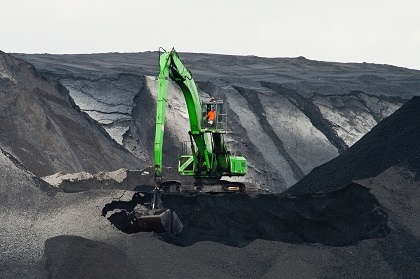
They are manufacturing in a rapidly transforming world, effecting change in the mining industry and warping the traditional practices of the industry at large. To meet the demands of safety and efficiency in mining, Volvo has announced a new automated solutions business area - aptly named Volvo Autonomous Solutions - that will hit the ground running in 2020. The new business area will continue to develop automation solutions for their products. Volvo Group write:
“Autonomous transport solutions, based on self-driving and connectivity technologies, are well-suited for applications where there is a need to move large volumes of goods and material on predefined routes, in repetitive flows. In such situations, autonomous transport solutions can create value for customers by contributing to improved flexibility, delivery precision, and productivity.”
Australia (and China) - leading the charge on automation
Mining operations globally have not yet fully assimilated into automating many of their services, but in countries like Australia, automation in the mining sector is quickly becoming the norm. Australian owned Resolute Mining is one of those companies automating many of their operations, and exporting the methodologies to mines they own around the world. They are famously automating their Syama mine in Mali, West Africa. It is expected to hold the title of the world’s first fully automated gold mine.
In their published financial results, Resolute Mining reported that they were nearing commercial production rates after their rollout of a network of automated technologies within the Syama mine.
“This represents the initial delivery of one of the main benefits of automation, the ability to maintain production over periods when operations would normally cease in a typical manual mine. This network enables the automated haulage loop, automated rehandle level, mine digitization and production automation, all of which allows operators to monitor and control mine production in real-time.”
Resolute Mining says that the workforce that would have been spending their days inside the mine can now spend their time upskilling and training themselves for new roles within the company - they do not intend to chip away at the workforce in Africa, but rather empower it. The menial drillers' job may be a thing of the past in the future of the mining industry, but the remote controller jobs are now open season.
Rio Tinto, an Anglo-Australian mining giant, has also made a considerable investment into automated mining equipment. In four of their iron ore mines in Australia, 73 driverless trucks are working around the clock, 24 hours a day. The command center that gives those driverless trucks the instructions they require to function lies 750 miles away in Perth, where employees of Rio Tinto keep an eye on all of the operations from afar. These are the remote control engineers of the mines, and they are a shining example of what automation has achieved thus far.
For other mining operations, however, the remote controller engineer job is not an open position yet, because the mining company has not gotten out in front of the digital disruption occurring in the sector. ReportLinker.com’s report on the Automated Mining Equipment Market, China has been dominating in the mechanization of their mines trumping the world average, but still remaining sluggish when compared to their own standards.
It seems that the fourth industrial revolution’s moderately fast march may be keeping engineers in their traditional roles in some emerging markets for now, but the Internet of Things technologies are rapidly transforming the industry and is expected to creep into most countries in the future. Interconnected and autonomous mining equipment seems unavoidable at this point, and the message to mining companies is clear: adapt or die.
Works Cited
FR, ReportLinker. “The Automated Mining Equipment Market Is Expected to Grow at a CAGR of 7.21%.” GlobeNewswire News Room, "GlobeNewswire", 11 Oct. 2019, www.globenewswire.com/news-release/2019/10/11/1928488/0/en/The-Automated-Mining-Equipment-Market-is-expected-to-grow-at-a-CAGR-of-7-21.html.
“Resolute Mining Starting to Deliver Automation Benefits at Syama Underground.” International Mining, 30 July 2019, im-mining.com/2019/07/30/resolute-mining-starting-deliver-automation-benefits-syama-underground/.
“Volvo Builds out Automation Offering on Industry Demand.” International Mining, 21 Oct. 2019, im-mining.com/2019/10/21/volvo-builds-automation-offering-industry-demand/.
Anicet Herve Engoue Kongoue is an EIT graduate, who completed our 52684WA - Advanced Diploma in Electrical and Instrumentation (E&I) Engineering for Oil and Gas Facilities in 2018. He said this program helped him advance his career, so he has now enrolled in our 52764WA - Graduate Certificate in Renewable Energy Technologies. He is a professional in the electrical engineering industry and currently works at Fayat Energie Services International. They specialize in electrical engineering projects and are focused on powering the smart cities of the future.
Anicet was always fond of engineering. From a young age, he was dreaming big. “My dream was to be a leader in the engineering industry,” he said.
His engineering journey began when he acquired a high school diploma in Electrotechnical Engineering from the Martin Luther King College in Bafoussam in Cameroon. In July 2007, he became a trainee technician at the FERMENCAM factory, which produces whiskey for the Cameroonian market. In the same year, he enrolled in a Diploma of Technology in Electrical Engineering and Industrial Computers.
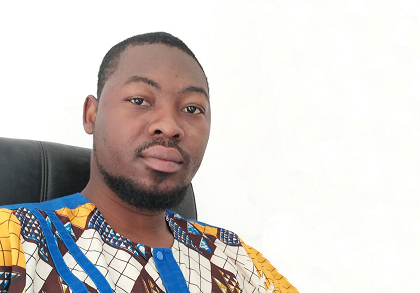
A year later, he was working as an Electromechanical Technician and became a team leader in the maintenance department at SOFAVINC, a company that creates a range of wine, liqueurs, and natural drinks in Cameroon.
From May 2013 to April 2014, Anicet moved on and worked as an electrical and instrumentation team leader in Areva, in Niger, for Satelec Fayat Group. In May 2014, he became an electrical and instrumentation supervisor at the same company, but he headed back to Cameroon, where he worked for one year.
In April 2015, he joined Fayat Energie Services International team in Mozambique as a quality engineer on the project of rehabilitation of Maputo international airport, where he stayed up to September 2017.
In September 2017, he worked as a quality engineer at Fayat Energie Services International for the Fayat Group on the Ivory Coast. He then went back to Cameroon in April 2018, to work for the same company as a quality engineer.
The hunger for knowledge never left Anicet as he was working in all of his roles. He wanted to master the technologies that he would see out in the field. So he decided to enroll in an advanced diploma with EIT.
“The course helped me to improve my work. I am more proficient in elements of safety and have an all-round better quality of work. While practically applying what I have learned from EIT, my employer always responds with satisfaction.”
He currently works as an AGL Manager at his old workplace Fayat Energie Services International, but this time he is located in Kenya. His daily responsibilities include:
- Execution and Supervision of Due Diligence Audits
- Audit Information Documentation and Processing
- Installation/Commissioning and Supervision
- Project Energy Resources
- Troubleshooting and issue rectifying
- Technical Reporting
- Implementing work procedure and quality documents
- Managing and supervising installation teams
- Ensure the respect of compliance and safety instruction
- Participate in project costing and design studies
Anicet has now set his sights on the future trends of engineering. He has recently enrolled in a graduate certificate with EIT to help him keep abreast of the developments and trends in the electrical engineering industry.
Anicet’s career has been an eventful journey, and it does not seem to be slowing down now. However, he is continuing to up-skill in his industry, so that he can be proficient in the newest technologies and have the most relevant skills. And he has not stopped dreaming.
“I think in the upcoming years, my career will be maturing, and I will be taking on more responsibility and will be in a more senior position,” Anicet concluded.
Roslyn Rountree is an Engineering Institute of Technology graduate who is obtaining a second qualification through the institute while working in the biomedical engineering field.
She completed her 52810WA - Advanced Diploma in Mechanical in 2018. She is now working through EIT’s 52705WA - Advanced Diploma in Biomedical Engineering program.
Her daily responsibilities include ensuring that medical equipment is working correctly, efficiently, and — most importantly — in a safe manner. Her job is two-pronged because she has to ensure both patient and hospital staff can use the biomedical devices.
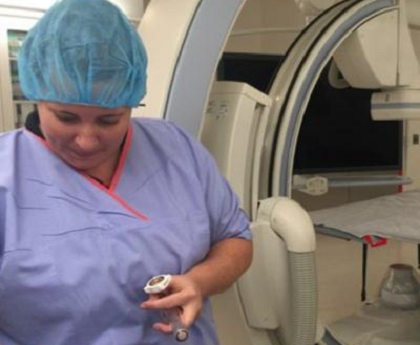
“My industry has multiple areas in which it cares for people,” she said.
“All of which are continually growing and developing every day, not only to improve patient care but also to improve how patient care is implemented.”
Rosyln’s journey has been everything but traditional. Her career initially began in agriculture. After graduating high school, she enrolled at Emerald Agricultural College. She acquired her Diploma in Beef Cattle and a Diploma in Rural Business Management.
After graduating from Agricultural college, Roslyn spent eleven years working in the mechanical engineering world. She found jobs as trade assistants in a few different mining companies and completed an apprenticeship as a diesel fitter. Worryingly, the jobs market within the mining industry was sluggish at the time Roslyn was looking for more work.
“I had experienced the roller-coaster of the mining industry more than three times,” she said.
“The last time left me looking for any job I could get my hands on as it was hard to find work within my industry at the time. On a whim and with a lot of doubts in my own abilities, I had applied for a mechanical cadetship with Biomedical Technology Services within Queensland Health.”
The cadetship saw Roslyn having to relocate from Mackay in Queensland to Brisbane in the same state. In Brisbane, she learned about surgical instruments at a workshop.
“This is where I learned multiple aspects of not only design but shaping techniques and a lot of hands-on skills from my mentor. A part of the cadetship was that I was required to study and gain an Advanced Diploma in Mechanical Engineering, which was through EIT.”
Once she graduated from the Mechanical Engineering program, not only did she gain the recognition as a Biomedical Mechanical Technician, she also felt a strong sense of accomplishment. Roslyn felt that learning theory was never her strong suit — she was more of a hands-on learner. During the course, she found EIT’s unique online training methodology, which combines theoretical and practical skill-building, was a better fit for her and helped her become a student of her trade.
After gaining insight and skills in the industry, she was ready to begin branching out and going cross-disciplinary. And as luck would have it, the branching out would take her to where her heart was: home.
“I was given the opportunity to apply for a transfer into the electrical medical aspect. If successful, I would be able to move back home to Mackay. Being successful in gaining the transfer, I was to study with EIT again to gain an Advanced Diploma in Biomedical Engineering.”
By April 2020, she will have completed her qualification. As her career matures, she predicts she will always have to have a finger on the pulse of what the biomedical industry is doing.
“Within the next five years, I will be looking forward to growing my knowledge on the workings of more specialized medical devices. You never stop learning in the medical industry, as there is always going to be new equipment, new upgrades, and continued development. So I am looking forward to seeing the growth in the years to come.”
Roslyn is now a living testament that with EIT and the determination to achieve in the engineering industry, one can take on many different roles in several different disciplines. She said EIT has assisted in facilitating her shifts between engineering disciplines.
“The engineering industry does not fit in a square box — there are so many angles and opportunities in the engineering world. Coming from a hands-on background, it allows me to use the skills in a different way and view things differently. There is no limit to where these types of industries can take you, within your own country, or even those traveling across the world.”
Technology is rapidly transforming the world of work. Traditional curricula in tertiary education institutions must change with the times to better prepare graduates for the technologies they will need to utilize once they enter the workforce. Likewise, students are wondering what roles they might have post-graduation, as the job landscape is continually evolving with automation.
Australia’s Institute Centre for Future Work agrees that students might enter roles that their degrees have not prepared them for. They conduct economic research on work, employment, and labor markets, and believe that educational institutions need to begin evolving their offerings to cater to the skills of the future within the majority of industries.
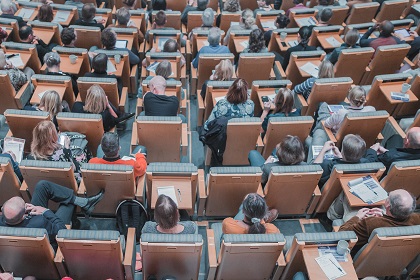
“Individuals with university degrees are more likely to be employed, to have more stable jobs, and to be paid more,” they stated in their report.
“But this relative advantage enjoyed by university graduates does not negate the fact that employment conditions have become much more challenging even for graduates. Rates of graduate employment in full-time work are down significantly over the past decade, and there is evidence of a growing mismatch and underutilization of university graduates in positions that do not fully or even partly utilize their hard-won knowledge and skills.”
Prospective engineers are, therefore, being encouraged to step out into cross-disciplinary avenues of the engineering world to make themselves as attractive to the workforce as possible. As a result, recent graduate engineers report that obtaining first-time employment has been swift.
Quality Indicators for Learning and Teaching (QUILT) provides prospective students with relevant and transparent information about Australian higher education institutions from the perspective of recent students and graduates. They reported in 2016 that 83.1% of engineering graduates found work in the first four months after graduation.
In 2017, QILT conducted further research and found that engineering graduates were the highest in demand in STEM (science, technology, engineering, and mathematics) industries. They found that 79% percent of engineering graduates surveyed had successfully found full-time employment.
Worryingly, in Australia, the sciences (natural, physical, biological, and medical) had the highest number of graduates but had the lowest percentage of graduates in full-time work at only 57%.
Australia Institute’s Center for Future Work says that in their findings, generalist degrees are becoming less useful in the world of work in the future. They do note, however, that the literacy skills attained from those kinds of courses are beneficial in a world of engineering expansion where smart machines and artificial intelligence are replacing menial tasks, and demanding more creative output from the employee.
“In an age of disruption and growing demand for critical, abstract and human-led inquiry, the knowledge acquired through university degrees will be crucial to the future economy,” they state.
“In Australia, degrees have an enduring and growing importance as job market entry qualifications; 32% of all jobs worked in May 2018 required a bachelor’s degree or higher qualification, and this share is projected to increase by one percentage point to 33% of all jobs by 2023.”
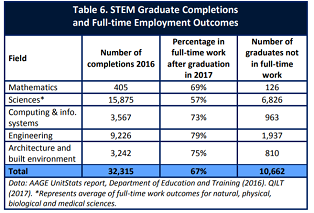
Globalization and digitization are warping the industries of education and training, and the world of work. The Engineering Institute of Technology’s programs are designed by an international body of industry experts, ensuring students graduate with cutting-edge skills that are valued by employers around the world. The program content remains current with rapidly changing technology to best prepare students for the workplace.
We offer industry-focused short courses and accredited diplomas, bachelor’s, and master’s degrees related to specific engineering fields, one of which is industrial automation. Our industrial automation programs marry electrical engineering with mechanical engineering and aim to prepare students for the jobs of the future.
Our short courses, called Professional Certificates of Competency, are designed to upskill engineers who already work within the industry. We provide professional development in specific areas, so they can further enhance their skills and continuing learning throughout their careers.
Our diplomas and advanced diplomas are vocational programs that deliver practical knowledge and aim to enhance the skills of people who come from a trade background and want to progress their career. Our degrees are designed to give our students both theoretical and practical knowledge required to enter the engineering world. Like all Australian higher education providers and universities, EIT programs are accredited by the exacting standards of the Australian Government’s Tertiary Education Quality and Standards Agency (TEQSA). Many of our degrees are recognized under international engineering accords.
Our unique online delivery model is designed to allow students to study from anywhere in the world while balancing life and work commitments. It makes use of live and interactive tutorials, an international pool of expert lecturers, dedicated learning support officers, and state-of-the-art technologies such as hands-on workshops, remote laboratories, and simulation software. Our supportive blended learning model and small class sizes encourage our students to advance their technical knowledge and remain engaged in their studies while forming global networks
Future and current engineers can be confident in the fact that the industry will continue to grow, but they must also be cognizant that they might end up a field they were never expecting to be in. That reality is beginning to define the future of work.
Works Cited
Pennington, Alison, and Jim Stanford. “The Future of Work for Australian Graduates.” APO, Centre for Future Work, 22 Oct. 2019, apo.org.au/node/264441?utm_source=APO-feed&utm_medium=RSS&utm_campaign=rss-research.
Winsor, John. “The Future Of Work Will Be Uniquely Human.” Forbes, Forbes Magazine, 23 Oct. 2019, www.forbes.com/sites/johnwinsor/2019/10/21/the-future-of-work-will-be-uniquely-human/#73a1a96416b7.
“The University Degrees You SHOULDN'T Be Doing If You Want to Get a Job in Australia after Graduation.” Daily Mail Online, Associated Newspapers, 22 Oct. 2019, www.dailymail.co.uk/news/article-7600247/The-university-degrees-SHOULDNT-doing-want-job-Australia-graduation.html.
On a Tuesday morning in late October, Danish engineers engaged in a risky and costly rescue operation to move one of Denmark’s most beloved landmarks. The Rubjerg Knude Fyr lighthouse was first lit in 1900 and is the Danish north coast’s jewel and a national treasure. However, due to coastal erosion, engineers have said the tourist attraction needed to be relocated.
The 76-foot tall lighthouse was 656 feet away from the coast when first lit in 1900. Each year, the sand dune has been eroding by approximately two meters. Before the relocation, the lighthouse was just 20 feet away from plummeting into the ocean.
As a consequence, the local government contracted local engineers to try and save the structure.
Engineers drew up plans to move the 720-tonne lighthouse in a way that would not compromise its structural integrity. The idea was to move the structure 70 feet away from its original position.

The mayor of the Hjorring Municipality said that many things could go wrong when moving the now unmanned lighthouse, but deemed it a risk worth taking.
The lighthouse was switched off in 1968, and soon after, it was converted into a museum documenting the effects of sand drift. Still, the tower reportedly attracts up to 250,000 people per year.
It is positioned on a gigantic sand dune on the western island of Jutland, atop a cliff that is 200 feet above sea level. A church building has already been deconstructed due to coastal erosion in the same region.
Engineers, however, did not think dismantling the lighthouse would be the best way forward. Therefore, they decided that the building would have to be moved atop a set of rails. They inserted the beams into the base of the structure and lifted it. They kept it lifted atop of the tracks and moved it along with the help of hydraulic jacks.
The engineers expected the move to last ten hours because they could only move 26 feet per hour. However, the process went much faster. The engineers initially thought the lighthouse would weigh 1,000 tonnes and be harder to move, but once they began work they found out it only weighed 720 tonnes.
“We could not go faster than 12 meters an hour because they needed to calibrate the hydraulics. It’s in sand and you need to ensure it runs well on two rails,” local builder Kjeld Petersen, who assisted the engineers in the lighthouse operation told the BBC.
The lighthouse move cost the local government only US $750,000. The move had been planned for a year and a half, and the entire prepping and relocation took ten weeks. The engineers are confident that the lighthouse should not be in too much danger due to erosion for the next forty years.
Works Cited
Associated Press. “Danish Workers Moved a 120-Year-Old Lighthouse before It Could Topple over the Side of a Sand Dune Cliff.” Insider, Insider, 22 Oct. 2019, www.insider.com/denmark-moves-120-year-old-lighthouse-because-of-erosion-2019-10.
“Danish Rubjerg Lighthouse Moved Inland on Skates.” BBC News, BBC, 22 Oct. 2019, www.bbc.com/news/world-europe-50139900?ocid=socialflow_twitter.
Could climate change prediction models and regional data collected by cities help ensure the safety of infrastructure in the future? Securing infrastructure like bridges and making them weatherproof is pretty important work. However, with more extreme weather events predicted for the future, how can engineers be sure their bridges will stay standing?
Engineers have life-cycle projections for bridges they have constructed. Although in a world threatened by more fierce climate events, the life cycle of bridges could be under threat. Predictive and preventative maintenance on bridges could be done in a much more informed manner if engineers were aware of future climate events and how those events could damage the structural integrity of bridges.
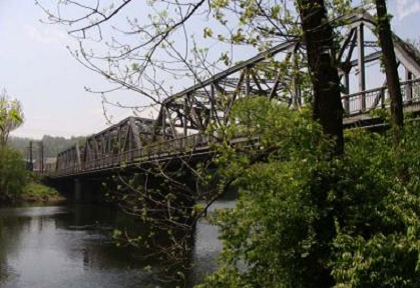
A less predictable threat to the structural integrity of bridges is scour. Scour is the erosion of soil around the foundation of a bridge caused by fast-moving water underneath it —typically during floods.
Scour is the most significant contributing factor to bridge failure in the United States. According to Ayres Associates, 82% of the 600,000 bridges in the National Bridge Inventory in the United States are built over waterways. With more and more climate events occurring globally, the likelihood of flooding, and in turn, scour increases.
As a consequence, engineering bodies are looking to academia to assess the impact of climate change on bridge safety. Lehigh University, a private research university in Pennsylvania, has put researchers David Yang and Dan M. Frangopol on the case.
The two researchers have published a paper in the ASCE Journal of Bridge Engineering under the title: ‘Physics-Based Assessment of Climate Change Impact on Long-Term Regional Bridge Scour Risk Using Hydrological Modeling: Application to Lehigh River Watershed.’
Research associate in civil and environmental engineering at P.C. Rossin College of Engineering and Applied Science, and co-author of the report, David Yang, said, “We know climate change will increase the frequency and intensity of natural hazards like hurricanes, heatwaves, wildfires, and extreme rains.
“For this paper, we’re looking at increased temperature as well as increased precipitation and their impact on bridge safety. The challenge here was that we didn’t know how to quantify those impacts to predict scour risk.”
Therefore, the researchers looked to climate data to see if they could produce a predictable model for structural safety in the face of climate events.
“We took a holistic approach. It started with a global climate model that was downscaled to regional hydrology. Then we used structural engineering to get the failure probability of a structure in a future flooding event,” Yang explained.
“From that, we could assess: does this structure failure pose certain risks to a community? So our model included these four steps of climatology, hydrology, structural engineering, and risk assessment.”
They conducted research and developed their own model by using flow discharge measurements in their local river, the Lehigh. They inserted global climate models as developed by the Intergovernmental Panel on Climate Change (IPCC), and added historical bridge foundation depth data in their local river, provided by the National Bridge Inventory. What they found was that flooding was becoming more common, and doubling in frequency as time went on.
The question now is how to export this model for other regions and make it useful for the engineering industry as a whole. Engineers will be better equipped to mitigate risk and plan for disaster far better than in the past with these kinds of models.
“You need to know the location of the bridge. For some communities, the failure of a bridge could be disastrous. For others, a bridge may not be as critical,” Dan M. Frangopol, an affiliate of Lehigh’s Institute for Data, Intelligent Systems, and Computation (I-DISC) said.
“This model helps you make that kind of decision because risk is not only based on safety but also on the consequence of failure. You might have two bridges at the same probability of failure, but the consequences of that failure could be very different.”
Civil and structural engineers can be sure that there will be more data-driven mechanisms that challenge their safety checks and balances in the future. With historic trends and future prediction models combined, there will be no running away from establishing meticulous safety procedures on bridges (their foundations in particular) and other infrastructure.
Works Cited
“Predicting the Impact of Climate Change on Bridge Safety.” ScienceDaily, ScienceDaily, 9 Oct. 2019, www.sciencedaily.com/releases/2019/10/191009075326.htm.
“What Is Bridge Scour? Why Should You Care?” Ayres Associates, 13 Sept. 2018, www.ayresassociates.com/bridge-scour-care/.
Hendru Coetzer is an Engineering Institute of Technology graduate who completed the 52726WA - Advanced Diploma of Applied Electrical Engineering in May 2016. It has been a twelve-year journey for Hendru, as he endeavored to learn everything he could about the engineering industry across the world.
From a young age, Hendru was obsessed with the engineering industry.
“It all started at a young age, where I used to either work with my father in his workshop or trying to assist his team at the tender age of 13. It’s in my blood. I still call my dad on a daily basis to assist with the most technical questions out there. Also, there is a certain smell to greased overalls and uncomfortable safety shoes which simply keeps me coming back for more.”
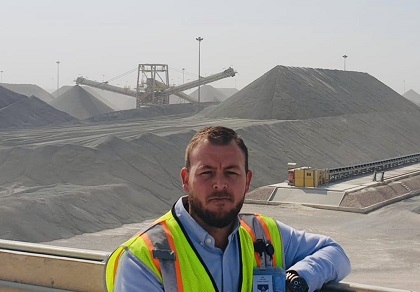 His first job was as a Junior Construction Manager at a low-cost housing project, where he began to save money in hopes that he could fund his future studies. He enrolled at a NECSA (the Nuclear Energy Corporation) training facility, which saw him develop his skills as an electrician, and millwright.
His first job was as a Junior Construction Manager at a low-cost housing project, where he began to save money in hopes that he could fund his future studies. He enrolled at a NECSA (the Nuclear Energy Corporation) training facility, which saw him develop his skills as an electrician, and millwright.
After his training, he found it particularly hard to find a job, which he needed in order to qualify for a trade test. Many months went by with no luck, but eventually he succeeded. He joined a small group of technicians at SASKO Bakeries in Johannesburg. Hendru says, due to restrictions, he was not able to get placement as an apprentice and was instead employed as a general worker with a minimal salary —and the hours were long too.
After working his shifts at the bakeries, he had enough hours to qualify. However, to take the trade test, he would have to take time off work, and he had not saved up enough money to do so. He also didn’t know if he would be prepared enough for it. He was stuck in between a rock and a hard place. Consequently, he decided to pack his bags and move to Doha in Qatar for work.
In Qatar, Hendru worked in a major mechanical, electrical, and plumbing company named Arabain MEP. For two and a half years he was an Electrical & Mechanical Coordinator on large scale projects. While he was employed, he still had a niggling feeling that he should further his education so that he could ensure success in his career.
“After completing my apprenticeship as an electrician, I wanted to increase my knowledge on an international level and found that EIT courses were the best suitable. On the platform, I found so many industry experts transferring their years of knowledge and experience through each module covered. And, because I had this course assessed successfully by SAQA (The South African Qualifications Authority), it proves the weight this qualification holds once completed.”
During this time, Hendru’s contact ended in Qatar, and instead of getting another job there, he decided to move back to South Africa to see friends and family again. He found a job in the Western Cape on a restoration project for the South African Police headquarters and a medical center. He also went full circle when he went back to South Africa — he completed his trade test. Equipped with new knowledge and skills from EIT, he says, he found the trade test to be one of the easiest exams he had ever taken.
“I truly felt the value of my advanced diploma that day. My employers reacted well to the qualification too. The course work gives you a good practical approach, which employers appreciate. You still need to prove that you are eligible to do the work and meet the high expectations that come with this qualification.”
Hendru’s obsession with engineering and working in the industry has seen him and his wife go to Sri Lanka and New Zealand, but eventually they decided to settle back in Qatar with their newborn daughter. He currently works at the Qatar Primary Materials Company (QPMC) and is in charge of mechanical equipment maintenance. His daily responsibilities include:
- Developing, modifying, testing, and evaluating all mechanical plant equipment.
- Providing technical advice about the suitability of materials and diagnosing faults.
- Advising on, planning and organizing inspections, maintenance, and repairs.
- Overseeing operational quality control processes and liaising with suppliers, customers, and manufacturing/development staff.
- Supervising the engineering and technical staff.
Hendru Coetzer is a prime example of an EIT student. He is dedicated, equipping himself with a spectrum of skills in a multidisciplinary approach to engineering. He is a lifelong learner who is giving himself skills while balancing a family and working life at the same time. We are proud to call him an alumnus of the Engineering Institute of Technology and wish him further successes in his career.
Engineers are the driving force behind the digital revolution. In just the last decade, there has been a rise in automation technologies that have turned menial tasks at almost every level of society into an automated process.
Emerson, a global technology and engineering leader, is designing automation solutions for engineers that they believe could propel the industry forward and increase efficiency. Emerson serves up automation solutions for a broad spectrum of engineering disciplines, including Automotive, Chemical, Industrial Energy & Onsite Utilities, Oil & Gas, Mining, Power Generation and Water & Wastewater.
Their latest solution to engineering efficiency is a set of new digital, cloud-based tools that can help individual engineers stay on top of their projects. The MyEmerson engineering tools promise to save engineers time and allow them to work on the things that matter.
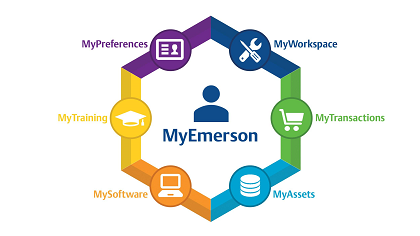
For instance, the online tool repository has on-demand CAD drawings and diagrams, plus configurators that can help engineers quickly create CAD drawings for the operations they need. Emerson says CAD drawings only take 15 minutes to be uploaded to their database, whereas it typically takes four hours to get CAD drawings to a user database in traditional engineering fields.
For engineers that work with gas, liquid, and steam, the MyEmerson application has a flow solutions technology advisor that can assist with measurements and provides configuration assistance for flow technologies specific to an engineer’s needs.
The online toolkit has various calculators, including:
- Power Module Life Estimator
- Appleton Lighting Retrofit Calculator
- Wireless Cost Savings Estimator
- ASCO Conversion Calculator (Metric/Imperial)
- Wireless Gateway Capacity Estimator
- ASCO Numacalc Pneumatic System Design Calculator
The application can assist with finding information on how to configure instrumentation found in the field — which purportedly helps engineers set instrumentation up at 93% faster than traditional methods. There is even a live chat that engineers can utilize to ask questions and get rapid answers from an online expert.
Emerson’s website states, “The process of specifying devices is often complex. From seasoned engineers to those new to the industry, it can be difficult to specify solutions for a range of applications.
“MyEmerson engineering tools allow you to confidently design solutions, regardless of your level of expertise. With these tools, you can quickly create a valid configuration, accurately select a device, generate required documentation, or calculate ROI. Use digital engineering tools to save time and augment your own expertise - to confidently engineer the best solution.”
The future of web apps for engineers
There are several web applications that engineers can utilize in their day-to-day operations to make their jobs easier. Doing back-of-the-envelope calculations and simulating engineering scenarios on the cloud before carrying them out in reality, is extremely popular with engineers.
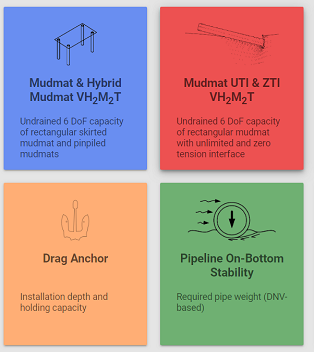
One website that hosts loads of engineering calculations useful for civil and structural, and mechanical engineers is webappsforengineers.com.
For those wading into the machine learning and big data sectors of the engineering industry, MATLAB Online is a useful tool. MATLAB is used for analysing data, developing machine learning algorithms and creating models and applications. With no installation necessary, and just a standard browser required, engineers can access a lightweight online app that can help them efficiently develop algorithms of the future.
Another engineering website that lists the top fifty free web apps for engineers is EngineeringDegrees.org. They lay the categories out according to; CAD Software, Calculators, Odds and Ends, Productivity, and Engineering Tools Overload. This new way of seeking out digital tools that help engineers calculate and simulate is changing the way they do their jobs.
Cloud synchronization for engineers within companies, and general web apps and digital tools that can assist engineers in their work are rapidly being rolled out to produce more efficiency in all industries. We can expect to see more online resources and smartphone apps that make the action of remote and on-site engineering much more complex and efficient.
Works Cited
“Engineering Tools.” Emerson US, www.emerson.com/en-us/automation/digital/engineering-tools.
“MATLAB Online.” MATLAB & Simulink, uk.mathworks.com/products/matlab-online.html#no-downloads-or-installations.
It was the curse of the commentator. Deloitte Risk Advisory Africa had just released a report on the lack of organizations’ preparedness for cybersecurity attacks in Africa. Soon after, hackers attacked the government of the City of Johannesburg in South Africa.
On the 25th of October 2019, employees of the City of Johannesburg found the following message displayed on their terminals:
“All your servers and data have been hacked. We have dozens of back doors inside your city. We have control of everything in your city. We also compromised all passwords and sensitive data, such as finance and personal population information.”
The hackers asked for a ransom of 4.0 Bitcoins, which would amount to US$30,392. They threatened that if the city did not pay it by the 28th of October, that they would upload all of the data onto the internet. In July 2019, the City of Johannesburg’s electricity utility, City Power, was also hit with a ransomware attack that ended up encrypting many of the computers on their servers.

Upon the release of Deloitte’s report on cybersecurity titled ‘2019 Future of Cyber’, Deloitte Risk Advisory Africa cyber leader Eric McGee said, “Cyber leaders are focused on digital transformation as a catalyst for change for the broader enterprise and their cyber agendas. The survey results show that organizations are no longer taking a wait-and-see philosophy to preparing for and responding to cyber incidents.”
Hacking events are becoming so frequent in the United States that the Californian government has just passed the Internet of Things Security Law, which is to take effect from the 1st of January 2020. The new law will require any IoT-ready device manufactured in California to have reasonable security measures built-in. Forty-one billion devices are expected to be connected to the Internet of Things by 2025.
The rise of cybersecurity
Ransomware attacks and other hacking endeavors perpetrated across the globe are damaging to individuals, businesses, and governments. Companies are having to invest heavily in protecting their servers.
Engineering Institute of Technology’s Dean of Engineering, Steve Mackay, said, “Industrial network security is a rapidly growing problem.
“It impacts on all of us — ranging from the president of a company to the electrician or tech installing a PLC or instrument. We have all been exposed to hack attacks and viruses and are very much aware of how tough it is out there protecting your industrial assets. In the future, security will be one of those metrics that you talk about in the same breath as safety and quality.”
He says that as the steady march of the fourth industrial revolution continues, more and more devices are connecting to the internet through the advent of the Internet of Things. While these devices are making the home, the office, and the factory more efficient, they are sitting ducks for hackers. Utilities and infrastructure utilize a similar set of sensors and equipment that automates their operations, and it all integrates with the Industrial Internet of Things (IIoT).
Electrical utilities may have once been able to run their operations on air-gapped computers — those being computers which never get connected to unsecured networks like the internet — but utilities long ago began using open standards such as Ethernet, TCP/IP, and other web technologies.
The cybersecurity jobs sector is growing at 37% every year, as more devices that connect to the internet come online. Forbes reports that at the start of 2018, the United States lacked half a million cybersecurity professionals. It is therefore imperative that already graduated engineers, or those just starting their journey in academia, look into adding cybersecurity proficiencies to their curricula vitae.
Works Cited
“City of Joburg Website Hacked.” ENCA, 25 Oct. 2019, www.enca.com/news/city-of-joburg-website-hacked.
“Risk Advisory: Risk Advisory: DeloitteZA.” Deloitte South Africa, www2.deloitte.com/za/en/pages/risk/solutions/risk-advisory.html.
Could the used coffee grounds from your morning coffee have a second life? Melbournian engineers think so — they have found the perfect use for coffee waste. In the future, houses and roads may have traces of coffee in them.
Concrete contains up to 80% sand, which is one of the planet’s most used resources. However, the demand is so high that we will not have access to this resource forever. Plus, sand is often part of fragile ecosystems, and extracting it can have a significant impact on that environment.
RMIT University’s School of Engineering is working on reducing the need for sand in construction materials along with the amount of coffee waste that ends up in landfill. They suggest replacing up to 10% of the sand in concrete with used coffee grounds.
 Senior lecturer at RMIT’s School of Engineering, Dr Srikanth Venkatesan, is at the helm of the research.
Senior lecturer at RMIT’s School of Engineering, Dr Srikanth Venkatesan, is at the helm of the research.
“The biggest challenge is ensuring the addition of spent coffee grinds does not lead to a reduction in strength of concrete, and this is the focus of further testing and development to make this product viable for use in real-world applications,” he said.
Bachelor of Engineering (Civil and Infrastructure) (Honours) students Senura Kohombange and Anthony Abiad also worked on the project.
“It seems fitting that we’re working on this project in Melbourne, a city known for its great coffee culture. We are very excited to present the project, share the idea with others, and showcase how some innovative thinking can turn a waste product into an everyday construction material,” said Kohombange.
According to statistics generated in 2017, there are an estimated 2,600 cafes in the City of Melbourne producing approximately 156,000 kilograms of coffee-ground waste every month. The researchers have been baking the coffee grounds into ‘coffee bricks’ to test their rigidity.
The idea of putting used coffee grounds into construction materials is not particularly new. A handful of universities were playing with the idea in 2016, Swinburne University in Melbourne.
Recycling is the word
As sustainable construction methods become the leading conversation in civil engineering circles, using recycled materials for building structures is becoming the norm.
Dubai Expo 2020 is on the horizon, and the United Nations is expected to have its own pavilion. The theme this year is: “Connecting Minds, Creating the Future.”
Innovation and design firm CRA-Carlo Ratti Associati unveiled their Italian Pavilion is going to look like when it opens to the public on October 20th, 2020.

With the theme in mind, their pavilion's skywalk will be integrating orange peels, coffee grounds, mycelium, and recycled plastics extracted from the ocean in their construction materials.
“Italy brings an Innovation Hub to Expo 2020,” Paolo Glistenti, General Commissioner for Italy at Expo Dubai 2020, said.
“A pavilion with an innovative structure, inspired by the most advanced elements of sustainability and circular economy, which will not simply be an exhibition venue, but a demonstration of Italian competence and the best national talent.”
Civil and structural engineers are being called to integrate sustainable, recyclable materials into their operations to ensure that greenhouse gas emissions stay low, and ecosystems get preserved. The industry is having to confront a world that expects better practices and cleaner processes. How might you integrate something like used coffee grounds or other domestic waste products into your operations? It’s time to become innovative!
Works Cited
“From Coffee to Concrete: Engineering Solutions to Our Most Pressing Problems.” RMIT University, www.rmit.edu.au/news/all-news/2019/oct/engenius.
“The Italy Pavilion.” Italia Expo 2020 Dubai, italyexpo2020.it/en/the-project/the-italy-pavilion/.
Snowy Hydro is an energy company that provides electricity to one million homes in Australia. They are the fourth-largest retailer in the energy market in Australia. Their crown achievement is the Snowy Mountains Scheme.
The Snowy Mountains Scheme was the most significant public works engineering scheme ever undertaken in Australian history. It was a quintessentially Australian engineering endeavor that began 70 years ago, to provide energy to the nation.
In 1949, construction began on their hydroelectricity and irrigation complex in Kosciuszko National Park, New South Wales. The Scheme would go on to consist of sixteen major dams, seven power stations, one pumping station, and 225 kilometers of tunnels, pipelines and aqueducts.
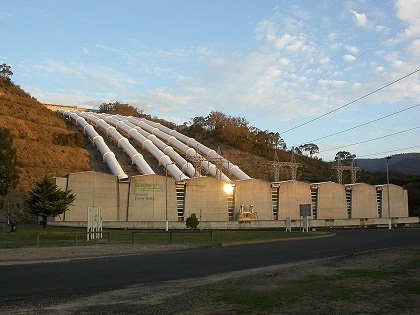
The scheme’s initial design saw it collecting and storing water that would have otherwise flowed east down the Snowy River to the coast. It was used for irrigation and environmental purposes. The engineers diverted that water through trans-mountain tunnels and power stations, and eventually released the water west of the Snowy Mountains into catchments at the River Murray and the Murrumbidgee River.
Before the scheme, the amount of snowmelt near the Snowy River region would cause floods, which in turn would make life harder for farmers by resulting in drowned crops. Therefore, the Snowy Mountains Scheme was a welcome workaround.
As population rates have grown to 24.6 million in Australia, compared to the eight million in 1949 when the Snowy Mountain Scheme began, an expansion of the hydroelectric project was deemed necessary. In 2017, Snowy Hydro asked professional engineering and development consultants SMEC, to undertake a feasibility analysis of a new phase of the Snowy Mountain Scheme.
In February 2019, the project was officially approved, which would see the Australian federal government pumping AU$1.38 billion into the project.
The scheme’s expansion will see pumps transporting water from the Talbingo Dam reservoir into the Tantangara. The water will flow down the waterway tunnel into the turbines that generate the electricity. At the same time, other pipes will continue to transport water back into the Tantangara.
On their website, SMEC details how the scheme works.
“Snowy 2.0 will act like a giant battery by absorbing, storing, and dispatching energy. Snowy 2.0 will pump water using electricity at times of low demand and store it in the upper reservoir. Then, when energy is needed most, the stored water will be used to generate and dispatch electricity within minutes. Pumping water at times of low demands means that Snowy 2.0 will have water ready to use for energy generation at times when consumers need it most.”
The project will add 2,000 megawatts of energy generation and provide 175 hours of storage for the National Electricity Market. The project is expected to power over half a million homes in Australia. Therefore, to ensure that demand is met over and above what Australia requires on any given day, Snowy 2.0 will work in tandem with wind and solar setups to ensure that there will be enough energy to go around when customers need it.
As part of the expansion, 27 kilometers (17 miles) of new tunnels must be dug. The construction of the project is set to conclude in 2024. Contractors, however, say that the project may take longer than expected and could only be in operation in 2027. The engineers — extremely confident that the project will be done by 2024 — say the hydro scheme will have a long life cycle.
One of the major plus points for Snowy Hydro 2.0 is that all of the infrastructure is to be built underground. Engineers say this makes the environmental impact of the project significantly less than what the alternative may have been.
Australia is pushing forward with the project despite a fairly large amount of criticism. The debate centers around what kinds of renewable energy technologies should receive more government investment.
Nonetheless, the beneficial aspects of the project for Australians may outweigh some of the criticism. More jobs for Australian engineers and a renewable source of energy are positive spin-offs to the project. Two thousand four hundred new jobs are a result of the construction phase, and 5,000 new jobs will exist after construction is complete.
Works Cited
“Snowy 2.0.” Smec, www.smec.com/what-we-do/projects/Snowy-2-0.
“Snowy Hydro: Renewable Energy.” Snowy Hydro | Renewable Energy, www.snowyhydro.com.au/.
Hi everyone,
The Engineering Institute of Technology will be rolling out two major changes throughout early December. These changes consist primarily of an upgrade of the system, and a complete design overhaul. These updates will occur throughout the 11th – 12th of December; with your access to Moodle intermittent throughout these periods.
Moodle Upgrade – 11th December
EIT’s Moodle platform will be upgraded on the 11th of December. While we undertake a Moodle upgrade annually, this upgrade will also encompass a total server enhancement; consequently extending the maintenance hours required. We expect the upgrade to take the entire day on the 11th, and will be prepared to resolve any residual issues that occur throughout the 12th.
It is essential for us to keep our systems up-to-date. We undertake an annual upgrade of our Moodle site for two primary reasons:
- Additional protection against hackers and spammers; protection of student data is EIT’s highest priority.
- Consistent patches; we’ve noticed a few bugs beginning to materialize throughout our Moodle site. These upgrades generally resolve them, as the open-source community that powers Moodle facilitates these fixes.
Moodle will be completely unavailable throughout the 11th of December, so we encourage any students currently studying to please download any materials they need before this day. All Learning Support Officers are aware of this upgrade, therefore any webinars or tutorials throughout this period have been rescheduled.
Following the upgrade; if any student notices any issues or problems with the site, then we encourage you to reach out to your LSO regarding these issues.
Moodle Design Overhaul – 12th December
Moodle will undergo a theme update on the 12th of December. The development of this theme was undertaken to achieve the following outcomes:
- Compatibility; our current Moodle theme is being discontinued. This brings about a myriad of issues from an administrator; imposing various issues with how the features of Moodle operate, and also exhibiting a security risk if ignored. The new theme we have selected is simply the default Moodle theme with additional styles applied on top.
- Accessibility; the focus of the new design was mobility and accommodating for poor internet connections. We have identified that a bulk of our students use mobile devices, therefore we intend on accommodating these users. Further accessibility criteria is standardize the course pages; ensuring that the overall navigation is relatively similar.
- Branding; EIT has undergone a branding overhaul this year, therefore we have added our branding to the new site. These consist of a logo update, and a few amendments to the colours.
Overall the changes are ultimately not too drastic. Our main focus is to improve the experience for students; minimizing all potential confusion that may be encountered with the new system.
Dashboard preview:

Course preview:

If you have any further issues with the upcoming upgrade and redesign then we encourage you to reach out to your LSO.
Volkswagen Group South Africa intends to take its manufacturing plant in Uitenhage, a town in the Eastern Cape Province, off the national electricity grid.
It is not surprising that companies are looking at more sustainable (and renewable) means of powering their facilities in South Africa. The country’s state-owned electricity utility has been plagued with problems in 2019 that have forced them into scheduling load-shedding on several occasions during the year. The impact of the resulting power cuts reportedly costs the country R2.5 billion (US$181 million) in business revenue every day the lights are off.

Thomas Schaefer, chair and MD of VWSA, explained how the power cuts affect the manufacturing plant.
“The robots are in the welding process, which takes about 30 seconds,” he said.
“If you get a spike in between, the robots forgets where it is. It’s an immediate shock and everything comes to a standstill. For safety reasons, you have to bring everything back into zero position but have potentially lost all the bodies in the shop that are half welded or damaged, which is a complete disaster. The spikes happen at least once a week. The cost of these lost bodies is easily into the double-digit million rand and impacts our profit margins.”
Volkswagen needs to keep its factory running as sustainably as possible — the factory has accounted for the production of over one million vehicles in 23 years. On 6 September, the milestone 200,000th VW Polo rolled off the line in Uitenhage.
Volkswagen’s plan to circumnavigate the power cut anomalies is to power their facility with biogas. To ensure the facility keeps running through the national grid’s down-time, VW has been investing in inverters — but the power cuts are becoming more frequent, and more needs to be done to keep the facility running.
Local abattoirs, fish facilities, and chicken farms will sustain the biogas facility in part, with other food companies sending their rotten produce to help power the factory.
Schaefer told media they expect to be running their facility off biogas in the next two to three years. The biogas facility will be set up near their factory and will feed electricity directly into the plant. The construction of the facility is set to cost them R3.5 billion (approx US$239 million) — which will include a waste separation setup.
The biogas facility will produce 600 kilograms of fertilizer ton of organic waste utilized during its operations. A positive spinoff for Volkswagen is that the fertilizer can be sold for a profit. They could reportedly earn US$400 per ton of fertilizer.
A delayed project?
The only thing keeping VWSA from getting on with the construction of the biomass facility is a signature from the minister of energy in South Africa. VWSA seems confident that they will be getting the green-light due to the electricity distribution issues Uitenhage has been facing.
It is in the region’s best interest to allow businesses to generate their own electricity and not put further pressure on the national grid. Furthermore, VWSA claims that the new plant could help curb the unemployment crisis South Africa is facing. They say the facility could add 1,000 jobs to the country, where the unemployment rate currently stands at 29%.
The company had to initially persuade the German parent company that the biogas facility was a good idea. They used the case of BMW South Africa, who have been utilizing biogas in one of their manufacturing plants since October 2015.
BMW utilizes a company named Bio2Watt to power its Rosslyn manufacturing plant in Pretoria. The company converts 300 metric tons of organic food waste and agricultural waste into methane-containing biogas for energy generation every day. VW’s system could work very similarly.
As South Africa’s energy and water scarcity issues are expected to plague the country well into 2020, manufacturers who account for a lion share of the export product in the country, look to innovative ways of powering their facilities. Renewable, clean, and reliable energy is what these manufacturers are interested in utilizing, and it is an exciting area of innovation that will produce more revelations in the coming months.
Works Cited
Cokayne, Roy. “VW to Take Its Uitenhage Plant off the Grid.” Moneyweb, 23 Oct. 2019, www.moneyweb.co.za/news/companies-and-deals/vw-to-take-its-uitenhage-plant-off-the-grid/.
“South Africa's Biogas Pioneer.” BMW Group, www.bmwgroup.com/en/responsibility/sustainable-stories/popup-folder/biogas-pioneer.html.
“VW to Take Its Huge Uitenhage Plant off the Eskom Grid.” TechCentral, 24 Oct. 2019, techcentral.co.za/vw-to-take-its-huge-uitenhage-plant-off-the-eskom-grid/93526/.
Australian and American engineers are working on a series of space missions that could ultimately culminate in putting humans on Mars.
The first mission, named Artemis, will involve getting humans back on the moon in 2024. It is expected to see the first woman walk on the lunar surface.
 Australian Prime Minister Scott Morrison visited the National Aeronautics and Space Administration on the 21st of September in Washington. The two nations’ space agencies have signed a memorandum of understanding that will see an exchange of engineering technology and expertise that will facilitate the continued development of the upcoming lunar and future Mars missions.
Australian Prime Minister Scott Morrison visited the National Aeronautics and Space Administration on the 21st of September in Washington. The two nations’ space agencies have signed a memorandum of understanding that will see an exchange of engineering technology and expertise that will facilitate the continued development of the upcoming lunar and future Mars missions.
Australia will spend US$150 million over the five collaborative years. According to the Queensland Times, the partnership will see the Australians delivering automated robots for use in space and telecommunications setups that will communicate between earth and the moon.
Nonetheless, Australia’s continued involvement with NASA is good news for future engineers in Australia.
“We’re backing Australian businesses to the moon, and even Mars, and back,” said Prime Minister Morrison.
“There is an enormous opportunity for Australia’s space sector which is why we want triple its size to $12 billion to create around 20,000 extra jobs by 2030. The growing amount of space sector work and innovation will also inspire the next generation to see the future of a career in these fields for the long term.”
Australia has partnered with NASA in the past; the deal that has been signed extends this partnership into the future.
“It’s been an incredibly cooperative relationship going back to the Apollo program into the moon landing,” A White House statement about Prime Minister Morrison’s attendance read.
“And what we are trying to do in this visit is to expand the longstanding cooperation into the next frontiers - the moon and Mars. And I think what you will see is that we are going to have some proposals on the table that will further integrate Australia and the United States into conquering those new frontiers.”
In a statement, NASA said, “Saturday’s joint statement strengthens the relationship between Australia and the U.S. and broadens the community of nations joining NASA in further exploration of the Moon, Mars, and beyond.”
Simulating Mars
Not only is Australia lending a hand on the technology and expertise side, but they are also letting engineers and scientists run wild in their backyard. NASA and the European Space Agency (ESA) have been setting up Mars simulations in the remote region of Pilbara in the north of Western Australia.
NASA was teaming up with the University of New South Wales Syndey’s Australian Centre for Astrobiology. They enlisted the help of these scientists to demonstrate how they go about identifying signs of life through the analysis of ancient rocks. Pilbara is home to the oldest fossilized lifeforms on earth; they go by the name ‘stromatolites.’
The demonstration will help NASA inform its NASA rover teams and eventual astronauts who eventually go to Mars what to look for on the surface of the red planet.
Director of the Australian Centre for Astrobiology, Martin Van Kranendonk, said, “It’s remarkable that the history hidden in the fossil record of ancient rocks from Australia’s Pilbara region will be vital for answering the question -- is there life on Mars? We were able to investigate signs of life’s earliest footholds in a variety of geological environments and then had extensive group conversations not only about what to sample but how to sample to maximize the possibility of mission success.”
Van Kranendonk concluded, “Just as the Apollo astronauts visited areas of geologic interest on Earth before they journeyed to the Moon, the scientists of Mars 2020 and ExoMars are doing their due diligence before their missions make the 100-million-plus-mile trip to the Red Planet”.
Works Cited
Alexander, Donovan. “Australia Will Be Assisting with NASA's Upcoming Lunar and Mars Missions.”
Interesting Engineering, Interesting Engineering, 22 Sept. 2019, interestingengineering.com/australia-will-be-assisting-with-nasas-upcoming-lunar-and-mars-missions.
Curtis, Katina. “Australia Makes Space Deal with NASA.” Queensland Times, www.qt.com.au/news/australia-makes-space-deal-with-nasa/3836712/.
Higgins, Isabella. “NASA Is Scouring the Outback for Clues to Mars. But the Evidence Is Being Stolen.” ABC News, 1 Sept. 2019, www.abc.net.au/news/2019-09-01/nasa-in-western-australia-looking-for-clues-to-mars-mission/11452250.
“Engineers can be a part of the solution. We all need to get together as a planet and do it collectively.”
Those were the words of engineer and sustainability consultant at BuroHappold Engineering, Trevor Keeling. He was taking part in the Global Climate Strike along with 1,799 other employees of BuroHappold Engineering worldwide who stopped work to encourage better climate practices from government and businesses alike.
In the last week of September, people in over 150 countries gathered to demand an end to what they describe as the ‘age of fossil fuels.’ Construction professionals, civil engineers, and architects were part of these strikes.

The Green Building Council in the United Kingdom skipped work on Friday the 20th of September to protest in London. The Royal Institute of British Architects (RIBA) supported the movement too.
The UK Green Building Council (UKGBC) wrote on LinkedIn, “The built environment is a significant contributor to carbon emissions. We believe our industry must make our voices heard to demand urgent climate action to achieve net zero carbon buildings. That is why we are joining with our members at the global climate strike this Friday.”
The UKGBC reports that the built environment contributes to around 40% of the UK’s total carbon footprint. They blame the growing carbon footprint on the way the construction industry implements heating in buildings.
“Direct emissions from fuel use in existing buildings rose for the second year running in 2016, mainly due to heating. Heating alone results in 10% of the nation’s carbon footprint, and homes are more significant than all other building types put together. Decarbonizing our heat supply is one of the big policy challenges ahead. Another challenge is the carbon embodied through construction. Annual embodied emissions alone are currently higher than the GCB’s target for total built environment emissions by 2050.”
More reflection on the cards
UK Construction Week 2019 ran from October 8-10. The fifth annual event took place in Birmingham this year and brought construction professionals together to reflect on the sustainability of the industry. The key focuses were:
- Modern methods of construction (MMC)
- Sustainability
- The digital revolution
- Diversity in the workforce and how they impact risk management, productivity
At the innovation stand at the UK Construction Week, Mitsubishi Electric demonstrated its low-emissions answer to heating technologies, to meet the challenges of the climate emergency. The company has engineered a heat pump named the Ultra Quiet Ecodan and is hoping to make home heating and cooling more efficient.
“The government has already recognized how important air source heat pumps will be for the future of low carbon heating in the UK and is forecasting one million sales a year by 2030,” Mitsubishi Electric manager for renewable heating systems Max Halliwell said.
“One of the key areas that will affect adoption of these energy-saving systems is noise, which is why Permitted Development exists, and these new units are designed specifically to overcome any issues with noise.”
Mitsubishi says that the sound pressure level on the heat pump is only 45dB(A), which for homeowners will be very quiet. 40db(A) is the average home noise, with regular conversation or background music being 60db(A). Therefore, it would be whisper quiet — which is beneficial to the homeowners over the long term.
Furthermore, it is the earth’s health the UK government is interested in too. An air-source heat pump is a system that transfers heat from the outside to the inside of a building. The Ecodan takes renewable heat energy from the air and pumps it into a building. For every 1kW of power it utilizes, it produces 3kW of heat energy.
It is clear that the future of the construction of buildings requires innovative solutions in the realm of electrical engineering. Cleaner technologies are being introduced to the market, which will be increasingly necessary to quell the fears of the society who are faced with a changing climate. Until then, schools and workplaces might face further future-focused protest action.
Works Cited
Living Environment Systems, 16 May 2018, les.mitsubishielectric.co.uk/latest-news/ultra-quiet-ecodan-takes-heat-pumps-to-the-next-level.
“Climate Change - UKGBC - UK Green Building Council.” UKGBC, www.ukgbc.org/climate-change/.
Week2019-09-23T11:27:00 01:00, Sponsored by UK Construction. “Innovation, Change and Reform at UK Construction Week.”
Building, 23 Sept. 2019, www.building.co.uk/sponsored-content/innovation-change-and-reform-at-uk-construction-week/5101757.article.
During the Great Recession of 2008, in the United States engineering companies began closing down. General Motors in Dayton, Ohio, was one such company that had to shut its doors due to the economic downturn.
This meant a factory was left empty and ready for a new tenant, and 2,000 workers were out of jobs.
Eventually, a new tenant from 7000 miles away, made their way into town in 2013. This was Fuyao Glass Industry Co. Ltd., a company owned by a Chinese billionaire Cao Dewang.
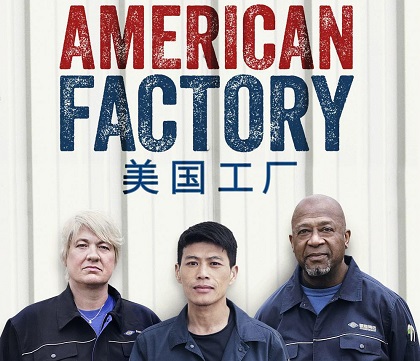
Fuyao is China’s largest automotive glassmaker that exports to both Chinese and international regions.
The factory takeover is the focus of a new documentary, ‘American Factory.’ It is the first film produced by Michelle and Barack Obama’s production company and was released on Netflix.
The documentary delves into the several complexities an engineering workplace would naturally see when two cultures meet. Factory workers used to an American leadership style quickly learn the intricacies of having Chinese managers presiding over them.
In the film, a newly employed American Furnace Supervisor is taught how the factory works by a young Chinese Furnace Engineer named Wong. Wong has 20 years of experience with furnaces inside glass factories.
The two are compelled to build up a working relationship. Mandarin-speaking Wong has to train English-speaking Rob.
“Wong and I have spent a lot of time together with him teaching me everything. Mother’s Day, we spent the whole weekend working together with our little translators talking back and forth. That’s when they told me that they had to be here two years, away from their family, no extra pay. That really made me start thinking and appreciating what they’re doing for us more and more,” Rob, the Furnace Supervisor in the documentary, said.
Automating the factory
The documentary ends with the directors guiding the attention of the viewer to the rise of automation that the world is seeing today. Inside Fuyao’s factory in Ohio, KUKA Robots have replaced some of the workers in the factory.
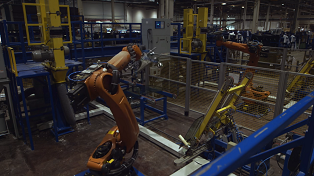
Workers who once picked and placed glass panes are no longer doing the job. The documentary shows a statistic about how automation is automating-out some of the workers in factories across the globe.
“Up to 375 million people globally will need to find entirely new kinds of jobs by 2030 because of automation. How workers, governments, and businesses tackle these seismic shifts will define the future of work.”
The globalization of engineering companies has led to a fusion of workplace cultures and labor practices around the world.
Works Cited
“American Factory.” Netflix Official Site, 21 Aug. 2019, www.netflix.com/watch/81090071.
Mui, Ylan Q. “A Chinese Billionaire Is Staking His Legacy - and Thousands of American Jobs - on This Factory in Ohio.” The Washington Post, WP Company, 26 Oct. 2016, www.washingtonpost.com/news/wonk/wp/2016/10/26/a-chinese-billionaire-is-staking-his-legacy-and-thousands-of-american-jobs-on-this-factory-in-ohio/.
Turning waste into a source of power is a big opportunity in the modern age. With the amount of plastic that is produced every day, building a cyclical ecosystem that can reuse plastic quickly is one way to reduce waste.
Emerging technologies invented by collections of scientists and engineers are springing up to assist with ridding the world of an overload of plastic.
A team of scientists at Washington State University has been hard at work turning plastic waste products into jet fuel. Hanwu Lei, an associate professor at Washington State University’s Department of Biological System Engineering said, “Waste plastic is a huge problem worldwide. This is a very good and relatively simple way to recycle these plastics.”
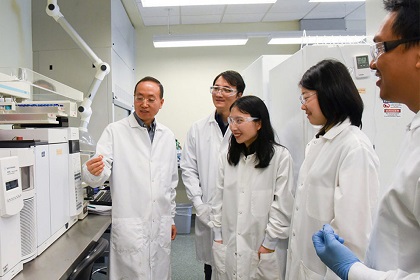
The team’s project saw them mixing low-density polyethylene and daily kinds of plastics like water bottles, milk bottles, and plastic bags. They reduced the plastic down to the size of a grain of rice.
The plastic granules are then placed atop activated carbon in a tube reactor that runs between 430 degrees Celsius to 571 degrees Celsius — the carbon acts as a catalyst by speeding up the chemical reaction.
“Plastic is hard to break down. You have to add a catalyst to help break the chemical bonds. There is a lot of hydrogen in plastics, which is a key component in fuel,” Lei explained.
The result of their process is a hydrogen-based fuel that equates to 85% jet fuel and 15% diesel fuel. The catalyst can then be reused on more waste plastic.
“We can recover almost 100 percent of the energy from the plastic we tested. The fuel is very good quality, and the byproduct gasses produced are high quality and useful as well,” Lei said.
Entrepreneurs are trying to get in on the business side of turning plastics to fuel, as well. Sierra Energy raised US$33 million in a round of investor funding.
They have a patented technology named FastOx. It is a process of gasification which sees oxygen and steam blasted at high temperatures in a modified furnace filled with waste. In turn, this leads to a chemical reaction that creates syngas.
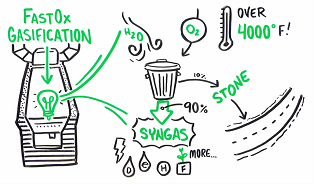
CEO of Sierra Energy, Mike Hart, told media, “It allows you to recycle the entire waste stream. The way we do that is by bringing the temperature of waste up to 4,000 degrees Fahrenheit, twice the temperature at the core of a volcano. At that temperature, everything breaks down molecularly.”
FastOx says that municipalities, landfills, waste producers, and developers should be looking at implementing the FastOx gasification technology. This syngas can be used to produce electricity, diesel, ethanol, hydrogen, fertilizer, and more.
The process produces 90% fuel. The ten percent of material left over is liquefied and recovered as metals and stone, which is sold off to construction companies that build roads — where it becomes part of the road base. As a result, there is almost nothing wasted; everything is reused.
The benefit of the processes from the University of Washington and Sierra Energy is that they are low-cost, efficient processes that can be replicated across a plethora of industries that produce waste plastics.
Works Cited
Peters, Adele. “This Startup Just Raised $33 Million to Vaporize Trash.”
Fast Company, Fast Company, 29 July 2019, www.fastcompany.com/90382101/this-startup-just-raised-33-million-to-vaporize-trash.
staff, Science X. “Research Group Finds Way to Turn Plastic Waste Products into Jet Fuel.” Phys.org, Phys.org, 3 June 2019, phys.org/news/2019-06-group-plastic-products-jet-fuel.html.
Globally, the fast-food industry generates revenue of more than US$570 billion, an amount higher than the economic value of many countries. With no signs of slowing down, fast food is an unbeatable global leader amongst industry, and they are now looking to automation to make their food even faster.
McDonald’s, the largest fast-food chain in the world, is aiming to automate almost every aspect of their operations so they can serve customers as quickly as possible. The starting point is replacing the most repetitive tasks within the restaurant, such as deep-frying operations and meal packaging.

Initial steps have already been implemented, with a majority of McDonalds’ now featuring automated kiosks for food ordering. The next move forward will be focusing on the drive-through experience and how it can be made more efficient. McDonald’s, according to Bloomberg, make 70% of their revenue from customers who utilize the drive-thru. And therefore, making the drive-thru even quicker could push their income up further.
To achieve this, McDonald's has recently signed a deal with a tech company, Apprente. Apprente has, for the last three years, worked at refining technology for the sole purpose of making the action of order taking at restaurants much faster.
McDonald’s has effectively purchased the company and is going to be opening a new branch. Steve Easterbrook, President and Chief Executive Officer of McDonald’s Corporation, said, “Building our technology infrastructure and digital capabilities are fundamental to our Velocity Growth Plan and enable us to meet rising expectations from our customers while making it simpler and even more enjoyable for crew members to serve guests.
“Apprentaee's talented team and the technology they have developed will form McD Tech Labs, a new group integrated into our Global Technology team that will take our culture of innovation one step further.”
Apprente has designed voice-activated technology that is set to replace the drive-thru talking box. To ease any delays that may be caused by artificial intelligence, McDonald’s also recently purchased a company named Dynamic Yield.
Dynamic Yield creates personalization technologies that aim to improve the customer experience at the drive-thru and the automated order kiosks. These artificially intelligent machines will suggest certain ordering preferences for each customer. McDonald’s acquired Dynamic Yield for the US $300 million. In the example of a clothing store, Dynamic Yield shows how they personalize a customer’s experience:
Nonetheless, Apprente is already testing out its technology in select McDonalds’ projects in the United States. They say that the AI-powered tech can hold a perfect two-way conversation with humans — and can even understand other languages than English. At one McDonald’s branch, the company has reportedly implemented the AI voice solution and further equipped the kitchen with robotic fryers that prepare the food.
“From early on, it was clear to us that McDonald’s is truly committed to technology innovation and that it was on a mission to spearhead the QSR industry. In partnership with McDonald’s, we set out to deliver a customer-focused solution, all while building a great team and culture,” Apprente said on their website, announcing the McDonald’s acquisition.
McDonald’s is by no means the only franchise looking to reduce the employee headcount. Globally famous coffee conglomerate Starbucks is acquiring software startups as well. The company has just purchased a stake in Brightloom.
Brightloom’s software will help the company open its menu up to an online system that customers can purchase from instead of queuing in-store. According to CNBC, ordering online increases a customer’s spend by twenty percent when compared to the alternative in-store cash purchasing.
Automation is about maximizing profits and ensuring efficiency. Some warn that over-automating the sector might automate-out most of its staff, leaving those employees jobless. For now, though, the restaurants are not announcing any staff cutbacks. They are instead trying to show how technology can free up some of its employees from doing menial tasks inside the business. They are trying to open up new pathways for productive work inside their companies, and automation has a big part to play. Nonetheless, for company and customer, the automation push is becoming a win-win.
Works Cited
Bloomberg.com, Bloomberg, www.bloomberg.com/news/articles/2019-09-10/mcdonald-s-buys-startup-to-add-automated-drive-thru-ordering.
Apprente. https://www.apprente.com/
McDonald's cutting calories in Happy Meals | 2018-02-15. https://www.foodbusinessnews.net/articles/11308-mcdonalds-cutting-calories-in-happy-meals
Afifi-Sabet, Keumars. “McDonald’s Orders up an AI Startup to Boost Drive-Thru Tech.” IT Pro, Dennis Publishing Ltd., Sept. 2019.
Nicola Beh is a Biomedical Engineering technician; however, her journey has not been a traditional one.
If you asked her, she would tell you that she never thought she was cut out for university life. Nonetheless, Nicola has equipped herself with the practical knowledge she needed to fulfill technical roles in the biomedical industry. Today, she walks up and down hospital wards keeping an eye on equipment due for service and spends her time repairing damaged hospital gear.

Nicola earned her 52705WA - Advanced Diploma of Biomedical Engineering at the Engineering Institute of Technology in 2018. We offer this diploma to address the immense growth of the biomedical engineering industry, which is rapidly advancing and producing jobs across the globe.
Nicola was predisposed to STEM (Science, Technology, Engineering, and Mathematics) from a young age. At school, she found that she was comfortable with physics and mathematics — other subjects completely bored her. Nicola was so dedicated to those subjects that even her English studies suffered. However, she made her way through high school and found that she had an affinity for technology.
Computer science was her specialty, but she notes that she couldn't sit still enough to be a programmer. She managed to get work in a government role in New Zealand as a trainee electronics technician. She spent time in a variety of departments picking up a host of electronics skills. However, things suddenly changed due to some government cutbacks.
“In New Zealand, the training scene was starting to change. The government was cutting costs, and training was one of the areas that cut back,” she said.
“Private industry had cut back on training as well. So, unfortunately, I never completed my training nor my New Zealand Certificate in Engineering, Electronics, and Computer Technology.
“I became somewhat nomadic and took on other roles; shop work, assembler, electronics technician, electrical switchgear fitter, machine operator, electrical apprentice, electrician, bed repair technician, renal technician, and now biomedical engineering technician.”
It was in her assembler role when she discovered her passion for biomedical technology. She started to seek employment in the biomedical field but found that many employers demanded tertiary qualifications to work in the sector.
“Before applying for the Advanced Diploma in Biomedical Engineering, I was a part-time, self-employed electrician and a contractor as a bed repair technician assistant at our local hospital. I heard about a hospital job being advertised for a renal technician to repair dialysis machines in which I successfully got the role,” said Nicola.
In her role as a renal technician, she saw the value in the practical experience that she had obtained in her several positions leading up to this one. She also realized she was way more capable of dealing with real-world situations and solving problems than she thought.
“When I followed through with an Advanced Diploma in Biomedical Engineering, it convinced future employers of my commitment to the field and that I had gained a wide field of practical knowledge and had furthered my communication skills.”
After qualifying through EIT, she finally managed to fill the role of biomedical engineering technician. She is one of a twenty member technician team that repairs hospital equipment, from simple blood pressure monitors to blood analyzers to telemetry systems.
Nicola has something she was always craving thanks to EIT: job satisfaction.
“The course has given me the confidence to self-manage my day and a heads-up on understanding how the equipment works and legislation. It has proven to me that I can do self-study in the latest research in whatever path I choose to study. I am sure I will never become bored!”
Scott Troiano has spent his career familiarizing himself with all aspects of electronics, currently working in the electronic testing, certification, and inspection industry. However, he is also an Engineering Institute of Technology graduate. With EIT, Scott has earned his 52726WA - Advanced Diploma in Applied Electrical Engineering and has now graduated a second time with the 52705WA - Advanced Diploma of Biomedical Engineering.
Like many others who have pursued engineering as their career path, Scott discovered his love for the profession in his younger years.
“I have liked tinkering with things and DIY since childhood but found, after falling into my first engineering job, a real interest in technology (specifically electronics),” he said.
“Also, I love being able to use both my brain and hands to work on solving engineering problems. I believe the engineering industry is one of the few that allows you to apply theoretical knowledge to produce real-world technologies directly.”
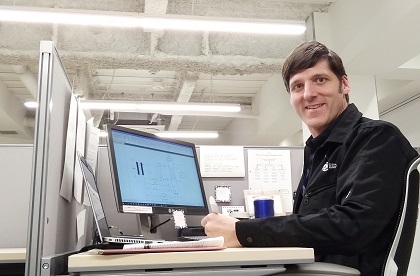
After graduating high school in 1996, Scott embarked on a four-year Electronic Tradespersons apprenticeship program that saw him gaining his Certificate III in Electrical/Electronics. During his apprenticeship, he worked for a small electronics repair shop as a Repair Technician before moving on to work for a large electrical products manufacturer as a Quality Control Officer. There, he conducted quality inspections on end products.
In 2002, Scott joined SGS Australia as a Project Officer, which saw him evaluating and conducting safety tests on electrical products, ensuring they complied with Australian standards AS/NZS. This role saw him working on power tools, fans, wiring/cable, and air-conditioners.
Scott then stepped away from work to spend a year traveling. After that year, he joined another certification body named Enertech Australia. He was working as a Safety Testing Officer, conducting safety evaluations of various products, including washing machines, household appliances, and gas cooking appliances.
In 2007, Scott moved across the world to Japan. Proving he could port his skills from one country to the next, he was able to join another certification body named TUVRheinland Japan. Working as a test engineer, Scott was appointed as a member of the equipment calibration staff. He gained experience with evaluating and testing products for IEC, CSA, EN, ANSI/AAMI, and JIS standards working on IT equipment and medical products.
“It was here that my interest in electrical medical devices began. This is also where I first gained experience in the calibration of measurement equipment.”
Before he pursued his newly found fascination for medical devices, he enrolled for the 52726WA - Advanced Diploma of Applied Electrical Engineering. EIT was one of the only institutions that offered fully online distance learning, allowing Scott to obtain formal qualifications while still working.
In 2012, Scott was on the move again. He was now working as a Project Engineer and Laboratory Maintenance Leader at Intertek Japan. It was in this role that he got his hands on medical equipment.
“Here, I focused on testing and evaluation of electrical medical devices and measurement equipment and gained experience with a wide range of medical equipment. Such as operation tables, X-Ray equipment, dental equipment, medical laser equipment, surgical cameras, microscopes, and ECG”.
Noticing that there was much to learn about the biomedical devices world, Scott felt that he required an academic approach to the field so he could master the industry. Equipped with the knowledge of his previous studying experience, he decided to enroll for the 52705WA -Advanced Diploma of Biomedical Engineering with EIT, graduating in 2019.
During that time, he managed to change roles once more. He began work for yet another certification body known as CSA Group Japan, working as a Product Safety Engineer.
“They were pleased that I was willing to study in my own time. And they were thrilled it was in Biomedical Engineering. I am studying something related to the devices we evaluate at work.”
Scott has settled at CSA Group Japan for the time being and is currently still working there. His daily responsibilities include electrical and mechanical safety testing of medical devices in a laboratory environment, evaluating technical documentation (standards, specifications, manuals), and communicating any information or findings to the medical device manufacturers. The technological development in the biomedical engineering industry is fascinating to Scott. He said:
“For me, the most amazing development in the medical device industry is to do with robotics and medical software. With these two technologies, there are numerous regulations and standards covering the evaluation of such devices.”
The multifaceted world of STEM
When asked whether he thinks people should pursue a career in STEM (Science, Technology, Engineering, and Mathematics), Scott said, “A career in a STEM industry is very rewarding - you will constantly be challenged, which helps you develop new skills constantly.”
“Also, because the skills and knowledge you gain in STEM cover a wide range of industries, there are many opportunities to discover. I believe it is really important to involve children in STEM from a young age, especially more girls, should be encouraged.”
Scott looks forward to taking on more teacher or mentor roles in his future and continuing his progress of becoming a professional in his area of expertise. We commend him for completing not one, but two qualifications with EIT and wish him well as he continues to develop his career and achieve engineering success.
The Royal Academy of Engineering MacRobert Award is the UK’s most prestigious honor for engineering innovation, recognizing “teams that demonstrate outstanding innovation, societal benefit and commercial success”. In 2019, the award went to the Bombardier team in Ireland that have developed and are now manufacturing the world’s first resin-infused wing designed for use in Airbus A220 commercial aircraft.
The company behind the resin that makes the wing possible is advanced material and specialty chemicals company, Solvay. Committed to developing chemistry that addresses key societal challenges, Solvay saw this project as a step towards getting more eco-friendly planes in the sky.
“Resin infusion isn’t traditionally used in aerospace”, explains David Bacon, Account Manager at Solvay’s Composite Materials business unit. “It’s typically used to manufacture boats, and in the field of wind energy. But it’s obvious there is a lot to gain in spreading its use in commercial aircraft manufacturing.”

The company says that using composite materials in the aerospace industry will utilize less metal than a traditional aircraft build. The replacement of metals, Solvay says, will help with increasing corrosion resistance, simplifying maintenance and making aircrafts lighter.
These developments also come at a good time as there is a significant mainstream focus on Co2 emissions and how much the aerospace industry is contributing to this phenomenon.
How it’s made
The wing is manufactured through a process known as a resin-transfer infusion (RTI), which involves putting dry carbon fiber into a mold and then filling it with liquid resin. The mould is then heated and pressured to obtain a solid fiber-reinforced part.
This process ensures faster production of simpler materials with stronger mechanical properties, which is largely beneficial to the aircraft manufacturing industry.
“In conventional wings, there are many parts to the torque box,” says director of quality, airworthiness, and technology strategy at Bombardier, Gavin Campbell.
“However, RTI allows the torque box to be made up from only four components…greatly reducing complexity in manufacturing and enabling improvements in mechanical performance because there are fewer points where the structure can fail.”
Bombardier’s team also built a fuel and hydraulic system into the wing. And to win the engineering award, one of the prerequisites was that the wing had to be lightning-proof. The engineers designed a special polymer bracket fitted with insulation that would dissipate the static electricity once lightning struck.
The factory where the wings are manufactured holds complex assembly stations that work on the wing after the RTI process. The continued assembly inside the factory is an unorthodox process with traditional wings normally sent off to another factory to continue the ongoing assembly process.
“It’s a totally digital factory, with all the sensors, use of simulation and digital twins that implies,” Campbell said. “However, we don’t tend to use terms such as Industry 4.0 because these are all developments of systems and techniques that we were using in the aerospace industry anyway.”
Overall, the new wings have been a great success for Bombardier, their sales helping deliver the first company profit for five years in 2018. The company delivered more than 25 wing sets in 2018, and this is expected to increase significantly in 2019.
Works Cited
Nathan, Stuart. “The Wing Master: Bombardier's Award-Winning Aerodynamic Production.” The Engineer, 9 Oct. 2019, www.theengineer.co.uk/wing-master-bombardier-award-winning-aerodynamic-production/.
Digital technologies are surpassing the more traditional methods of running engineering companies. As industrial automation begins to infiltrate engineering sectors, companies are drastically changing the way they operate to keep up.
On the 26th of September 2019, Jaguar Land Rover (JLR) opened a new automotive creation and development center in England. The center will bring JLR’s engineering, manufacturing, designing, research, and development teams all under the same roof.
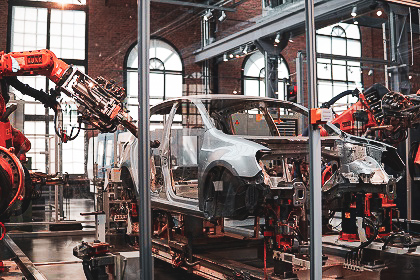
“We are now an IT company,” said JLR CEO Ralf Speth.
“We have to go away from the old way of doing things.”
The overarching theme of the facility is automation, with JLR’s entire manufacturing process now being automated, delivering a clear message that JLR is changing with the times.
Hardware has also taken a backseat at the heart of the manufacturing process, as the company has shifted its focus to new and improved smart-features within their vehicles. The challenge of creating new software is now their new priority as “100s of millions of lines of code” are currently in development.
At the launch of the site, JLR’s head of engineering, Nick Rogers, said that the number of traditional mechanical engineering staff is beginning to dwindle as the number of software, mechatronics, and electrical system engineers they require for their manufacturing process increases.
The center cost nearly one billion dollars and will be employing around 13,000 engineers, officially making it the largest car creation center in the UK. And automation is not the only trend that is making JLR rethink its future.
“Megatrends like urbanization and sustainability are fundamentally changing the automotive industry. At Jaguar Land Rover, we not only participate - we are shaping future mobility. Our vision is for a world in which zero-emission vehicles, public transport, and self-driving pods will form one smart integrated and networked transport system,” said Speth.
Destination Zero
Ralf Speth says that mobility needs to become a human right in the future. However, that gives automotive companies a mandate of making mobility as safe as possible.
Land Rover has conducted real-world tests of innovative connected and autonomous vehicle technology, and have been developing in the space for the last four years. Recently, they took a self-driving Range Rover around one of the UK’s most challenging road layouts.
<iframe width="696" height="392" src="https://www.youtube.com/embed/dKr1xfXrTys" frameborder="0" allow="accelerometer; autoplay; encrypted-media; gyroscope; picture-in-picture" allowfullscreen></iframe>
JLR is predicting that autonomous vehicles will be the answer to solving road accidents in the future. They have dedicated themselves to Destination Zero, committing to achieving zero accidents, zero congestion, and zero emissions. JLR also intends to have all of its vehicles powered by electronic means by 2020.
Jaguar Land Rover is now a picture of an innovative company that is keeping its finger on the pulse of what consumers not only want but demand.
Works Cited
Gibbs, Nick. “Jaguar Land Rover Is an IT Company Now, CEO Says.” Automotive News Europe, the 30th of September 2019, europe.autonews.com/blogs/jaguar-land-rover-it-company-now-ceo-says.
Blog - Steve Mackay
EIT's Technical Director, Steve Mackay, enjoys keeping his blog up-to-date with useful tips and current industry matters for his fellow colleagues. He has a loyal and expanding following base reaching over 300,000 people around the world.
Student Stories
In this section you have the opportunity to read and listen to EIT students talking about the reality of the programs. Discussions are wide-ranging and include information about the study commitment required, the value of the qualification in their careers, the relevance of the subject matter, future pathways, and more. They provide valuable feedback for you to take into account before you decide to join one of our programs.
Career Information
Latest career information including industry research, podcasts, blogs, life hacks and general information about how you can make the most out of your career.
Education
Here you will find out more about the latest trends and developments within education worldwide, along with some helpful articles regarding study tips and keeping on track with your studies.
Developments
The latest innovation and inventions from the world of engineering can be found here. Learn about advances in technology and how they can make a real difference within your industry.
Announcements
Keep up to date with the latest announcements from the Engineering Institute of Technology. In this section you can read more about new courses, new recognition from professional bodies, our Excellence in Teaching Award, upcoming free webinars and much more.
Monthly Update
We understand that you may not have time to read all the articles that we post, so our monthly update gives you access to some fascinating articles which cover the best of the months news in a compact format.
